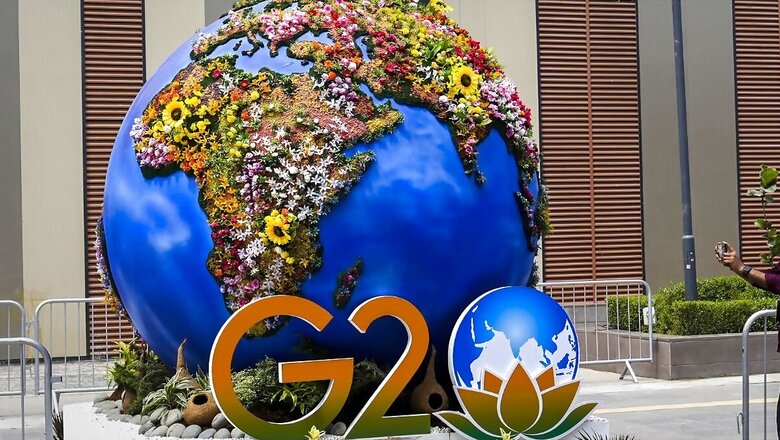
views
Bharat Mandapam, the venue for the G20 summit, showcases a unique international project – ‘Culture Corridor – G20 Digital Museum’. The culture corridor represents and celebrates the shared heritage of G20 members and invitee countries. It incorporates iconic and notable cultural objects and heritage of the G20 members and 9 invitee countries.
This culture corridor serves as a powerful platform for promoting understanding and appreciation of diverse cultural expressions, for knowledge sharing, inclusivity and equality, and for fostering a sense of shared identity.
This project is based on India’s G20 theme ‘Vasudhaiva Kutumbakam’ and the Culture Working Group’s (CWG) hallmark campaign ‘Culture Unites All’. This corridor was unveiled on September 9, 2023.
The country-wise details of cultural objects and heritage of the G20 members and 9 invitee countries:
INDIA: Ashtadhyayi
This is a manuscript of the Ashtadhyayi, an iconic grammar treatise composed in the 5th-6th century BCE by the celebrated grammarian Panini. This text, through eight chapters and 4,000 sutras, captures the science of Vedic phonetics and grammar. The grammar in Ashtadhyayi has been likened to the Turing machine, an idealised mathematical model that reduces the logical structure of any computing device to its essentials.
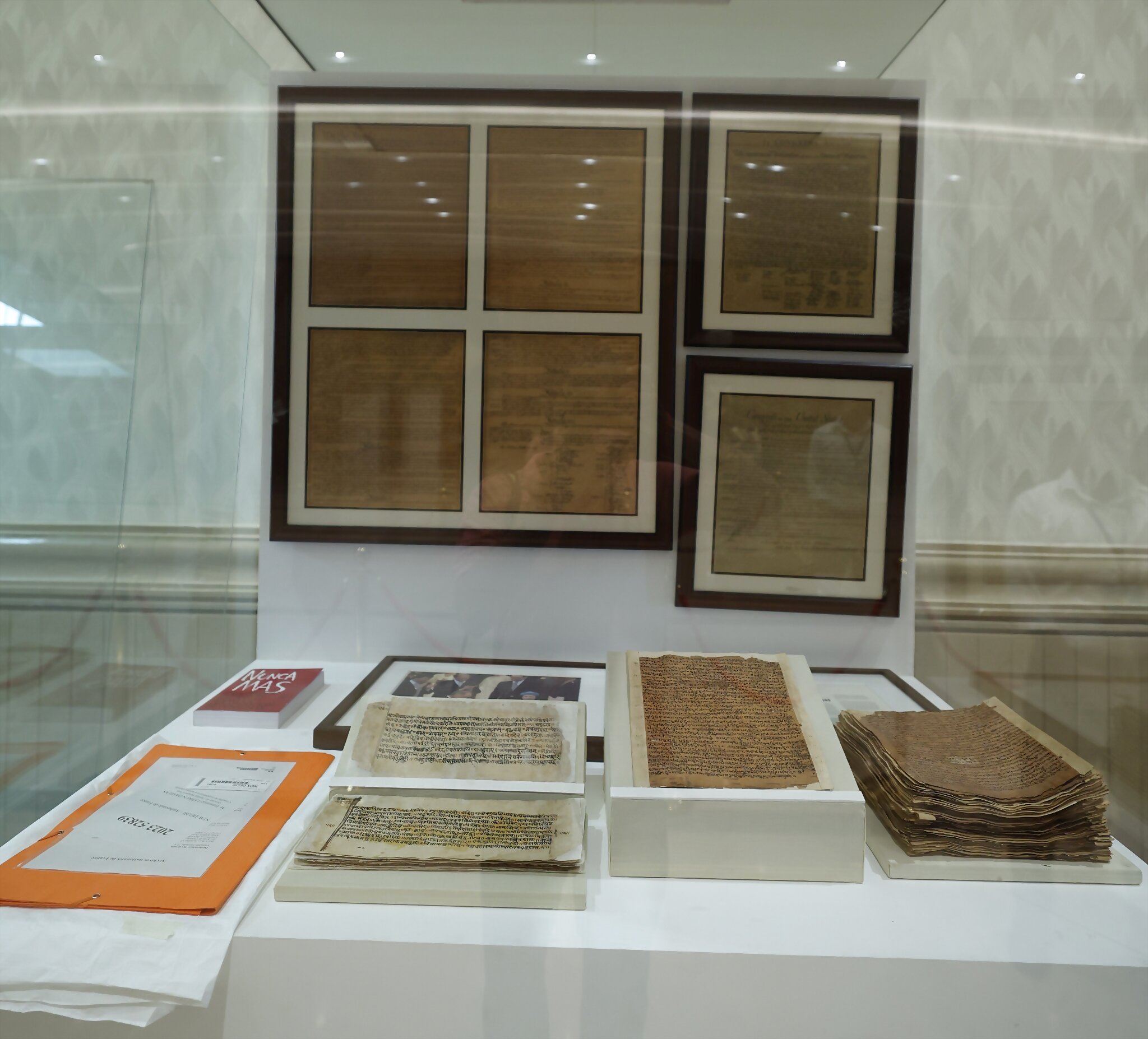
By allowing elements of earlier rules to recur subsequently, Panini anticipated the idea of computer programs by over 2,500 years. Historian A.L. Basham underlined the text’s significance in the following words: “Panini’s grammar is one of the greatest intellectual achievements of any ancient civilisation, and the most detailed and scientific grammar composed before the 19th century in any part of the world.”
The #G20 Summit in India presents Bharat Mandapam exhibitions, including the 'Culture Corridor – G20 Digital Museum.' Delegates access UPI One World with Rs 2000 prefunded wallets. RBI showcases revolutionary financial technologies.#G20SummitDelhi @g20org @G20_Bharat pic.twitter.com/tTgHUdfxk2— SansadTV (@sansad_tv) September 8, 2023
INDONESIA: Batik sarong textiles
Batik attire holds sacred significance in Javanese culture, crafted by applying melted wax onto fabric. The term Batik denotes the connection of dots on a wide cloth. While metal monotype is largely used for applying wax through the block-printing method, delicate Batik can be produced by employing the canting, a pen-like tool used for printing intricate motifs.
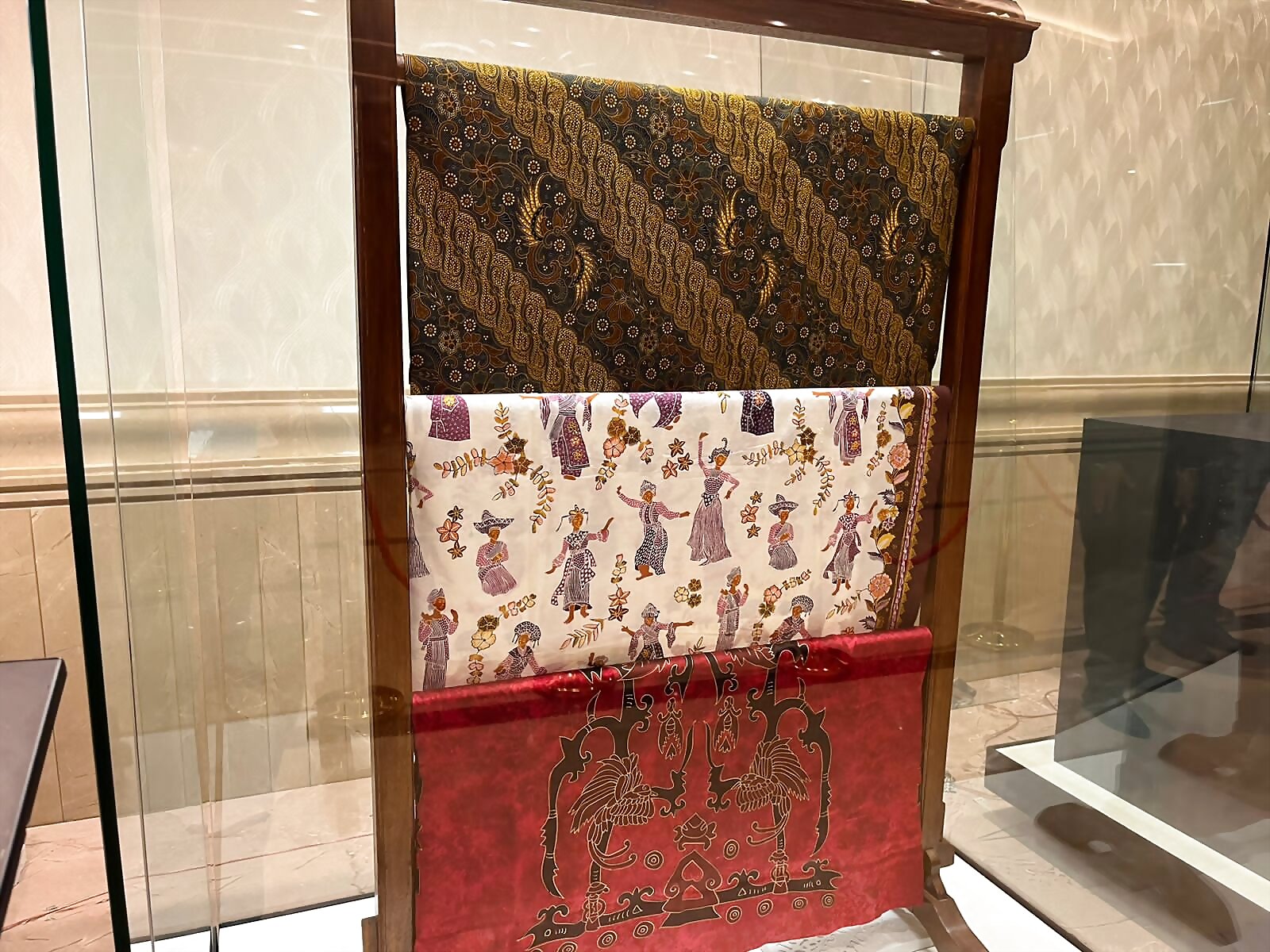
Beyond attire, Batik historically influenced courtly affairs and has subsequently diffused through Indonesia’s social fabric, leaving behind its exclusive association with Java. The display on top portrays waves of progress, while the one in the middle reflects contemporary Jakarta design, free from conventions.
The lower piece hails from Papua, Indonesia’s eastern-most province, showcasing regional distinctiveness. To revitalise Batik and promote it to the younger generations, the government of Indonesia has introduced ‘Batik Day’ on 2nd October. In 2009, Batik was announced as a masterpiece of the ‘Oral and Intangible Heritage of Humanity’ by UNESCO.
BRAZIL: Model of the National Parliament Palace of Brazil
Brasília’s iconic National Parliament Palace stands as a cornerstone, anchoring the Monumental Axis and neighboring ministries. It commands a vertex within the ‘Praça dos Três Poderes’ alongside the President’s Palace and Federal Supreme Court. The Parliament complex features a broad main structure supporting the domes of the Federal Senate and Chamber of Deputies.
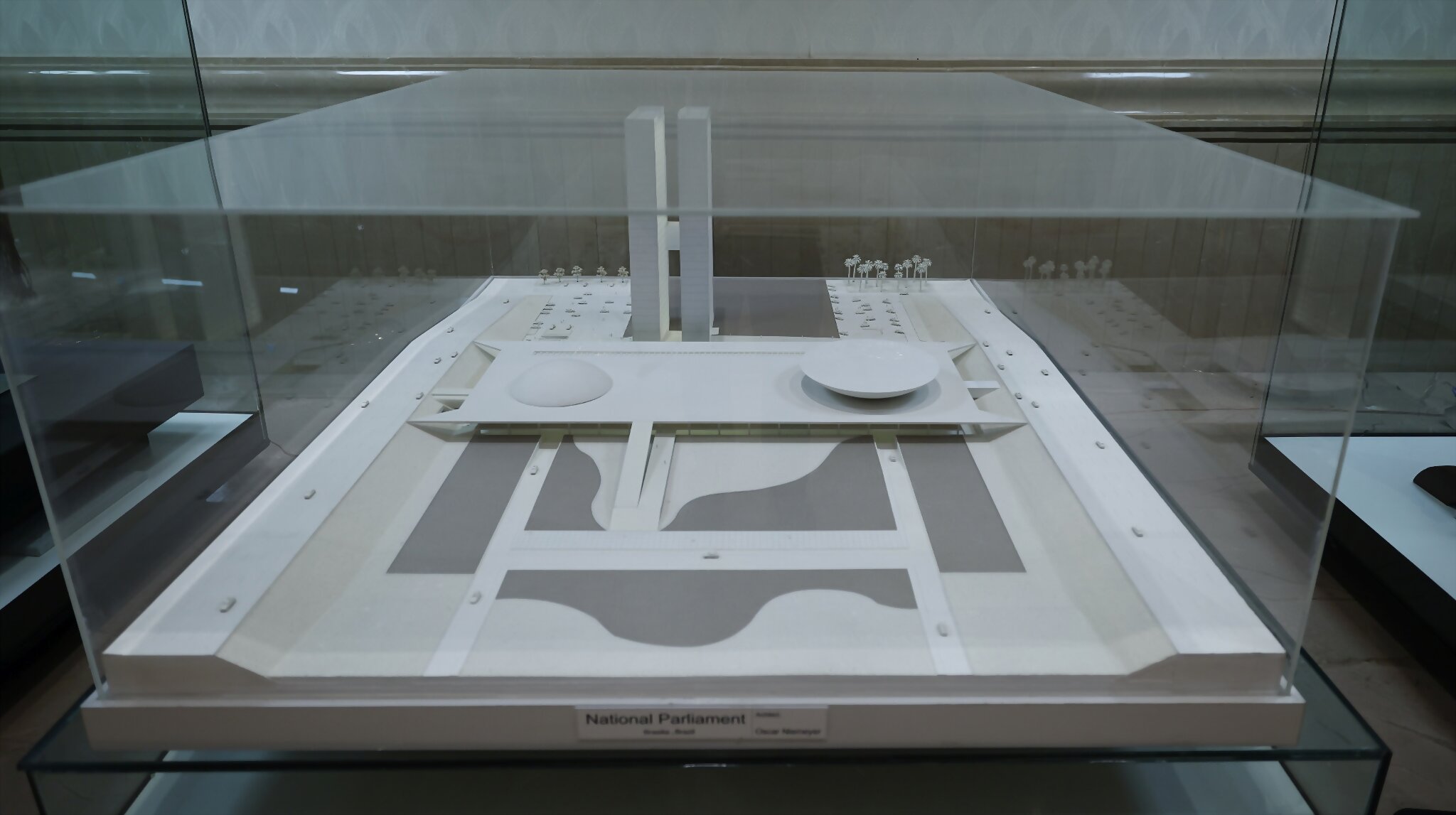
Two 28-storey office towers — one for each branch — are located between the domes. Celebrated Brazilian architect Oscar Niemeyer envisioned this masterpiece, marking his indelible contribution to Brasília’s architectural landscape. Beyond aesthetics, the design eloquently embodies Brazil’s democratic spirit, making it the heart of the nation’s governance.
ARGENTINA: Poncho
The poncho is a rectangular cloth with a central head opening, first discovered in the San Juan province around 1,100 CE. Its functions range from protection against inclement weather to identity markers. The poncho on display is a creation of master-craftsman Graciela Salvatierra, who has woven it on the Criollo loom.
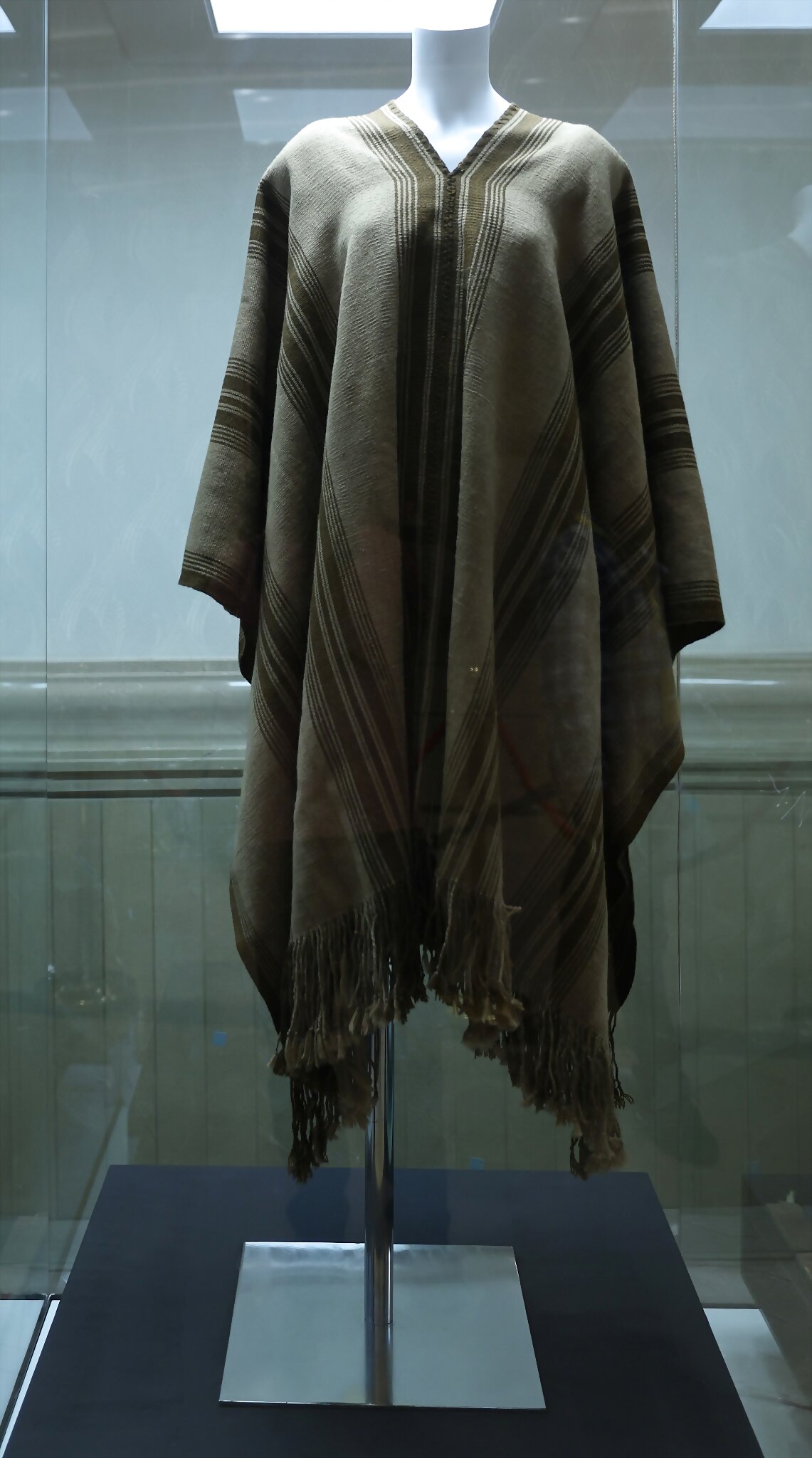
It reflects the traditions of her hometown, Londres, Catamarca province, where artisans use black carob-tree and walnut-shell to dye ponchos. The woven parts are symmetrically sewn and embroidered post-weaving. The fringe, in this case, is an extension of the weave. This poncho encapsulates a blend of history, technique, and community artistry, giving it enduring cultural significance for Argentinians.
A Symphony of Cultural UnityDuring the #G20India Summit, a unique international project – ‘Culture Corridor – G20 Digital Museum’ has been curated at Bharat Mandapam, which will represent and celebrate the shared heritage of G20 members and invitee countries through iconic and… pic.twitter.com/8iBATCXWFP
— Meenakashi Lekhi (@M_Lekhi) September 8, 2023
AUSTRALIA: Yiŋapuŋapu at Djarrakpi
This painting by master artist Narritjin Maymuru, completed in 1963, is synonymous with the rich cultural tradition and folklore of the Yolŋu people.
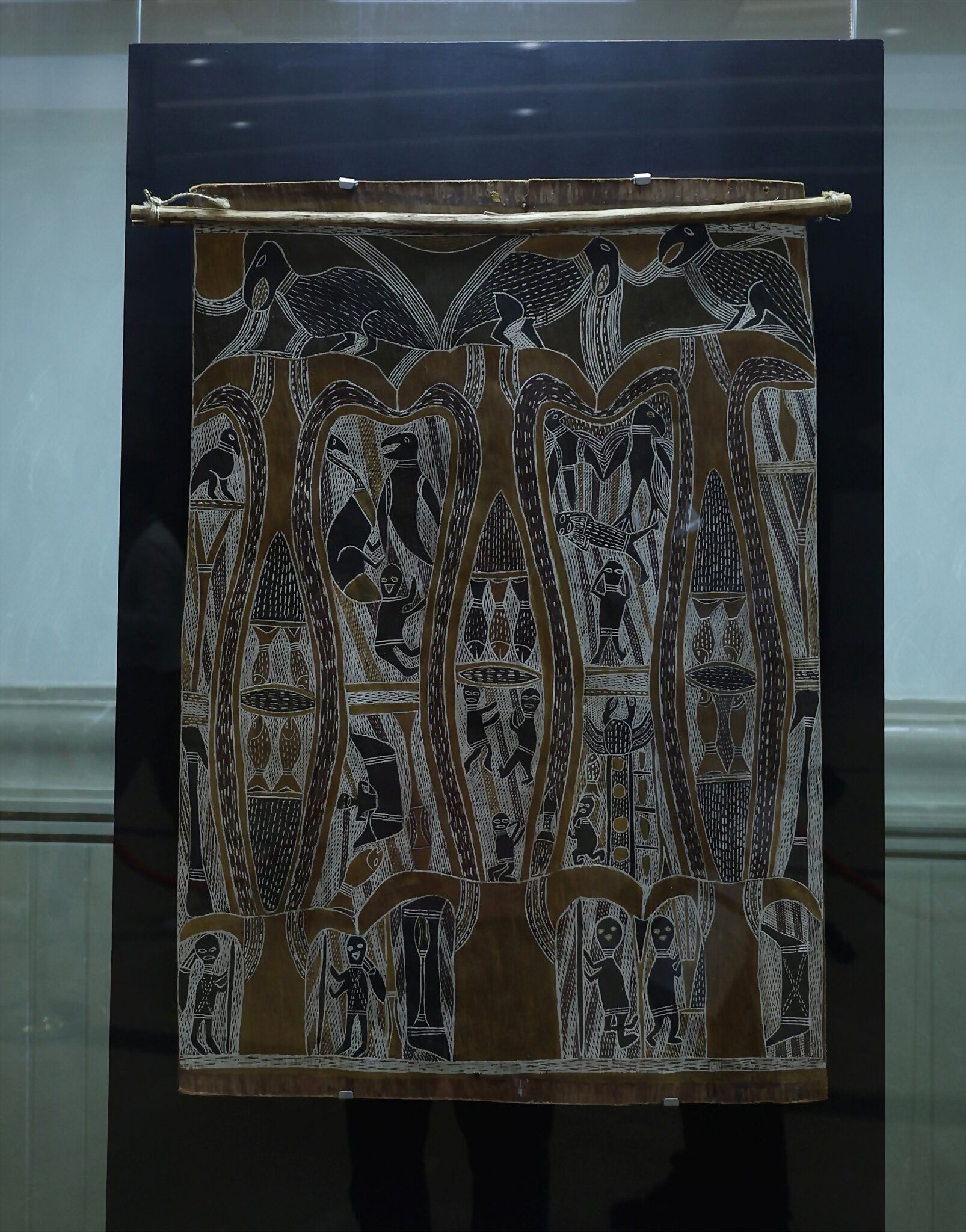
Yolŋu, an aggregation of aboriginal Australian people, inhabit north-eastern Arnhem Land in the Northern Territory of Australia. The painting captures the story of birth, death and renewal with vivid elements and bold motifs to engage the viewer.
CANADA: Sea Monster Transformation Mask
Master carver Calvin Hunt crafted the Sea Monster Transformation Mask for his debut solo exhibit, YUXAN KIS’O (These are Our Treasures). This mask’s narrative harks back to an origin tale wherein an underwater monster safeguarded a Kwakwaka’wakw village from deluge. Calvin’s distinct touch is evident in the mask’s proportions, modern design, and intricate detailing.
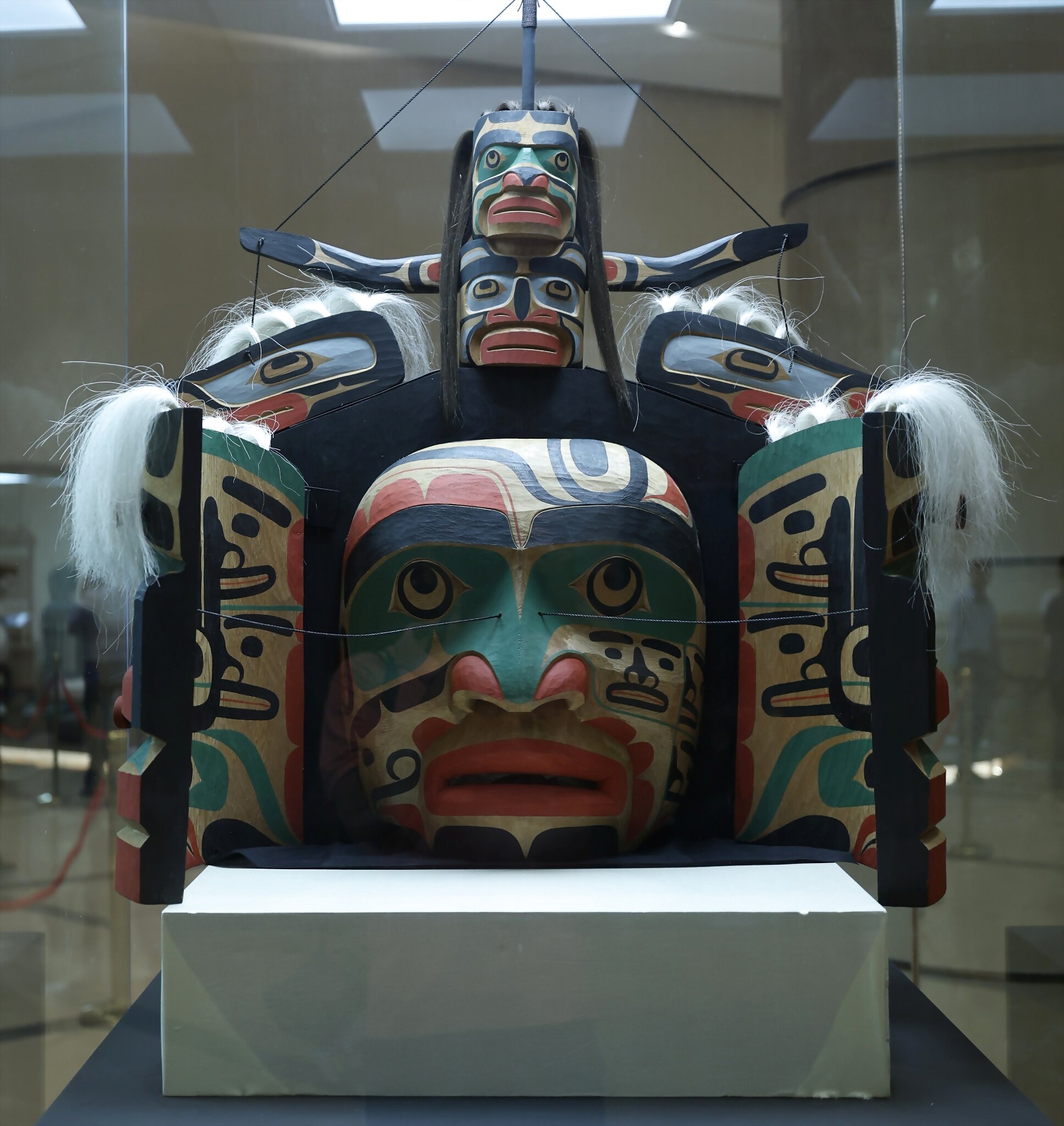
As Hereditary Chief of Mowachaht/Muchalaht First Nation, he is acclaimed for designing monumental sculptures, totem poles, expansive masks, house posts, and canoes. An inductee of the Royal Canadian Academy of Arts, Calvin received the BC Creative Achievement Award for Aboriginal Art in 2009. The mask resonates with ancient traditions and reflects the stellar aboriginal heritage of Canada.
CHINA: Fahua lidded jar with lotus pond design
This rare fahua ware is a precious creation from the Qing emperor’s official kiln. Originating in the Yuan dynasty, the fahua technique involves intricate raised designs filled with ground-colored enamels before kiln firing, which is similar to the cloisonne technique. This piece reveals finer detailing than predecessors, using famille rose (powdery colours) enamels for added intricacy.
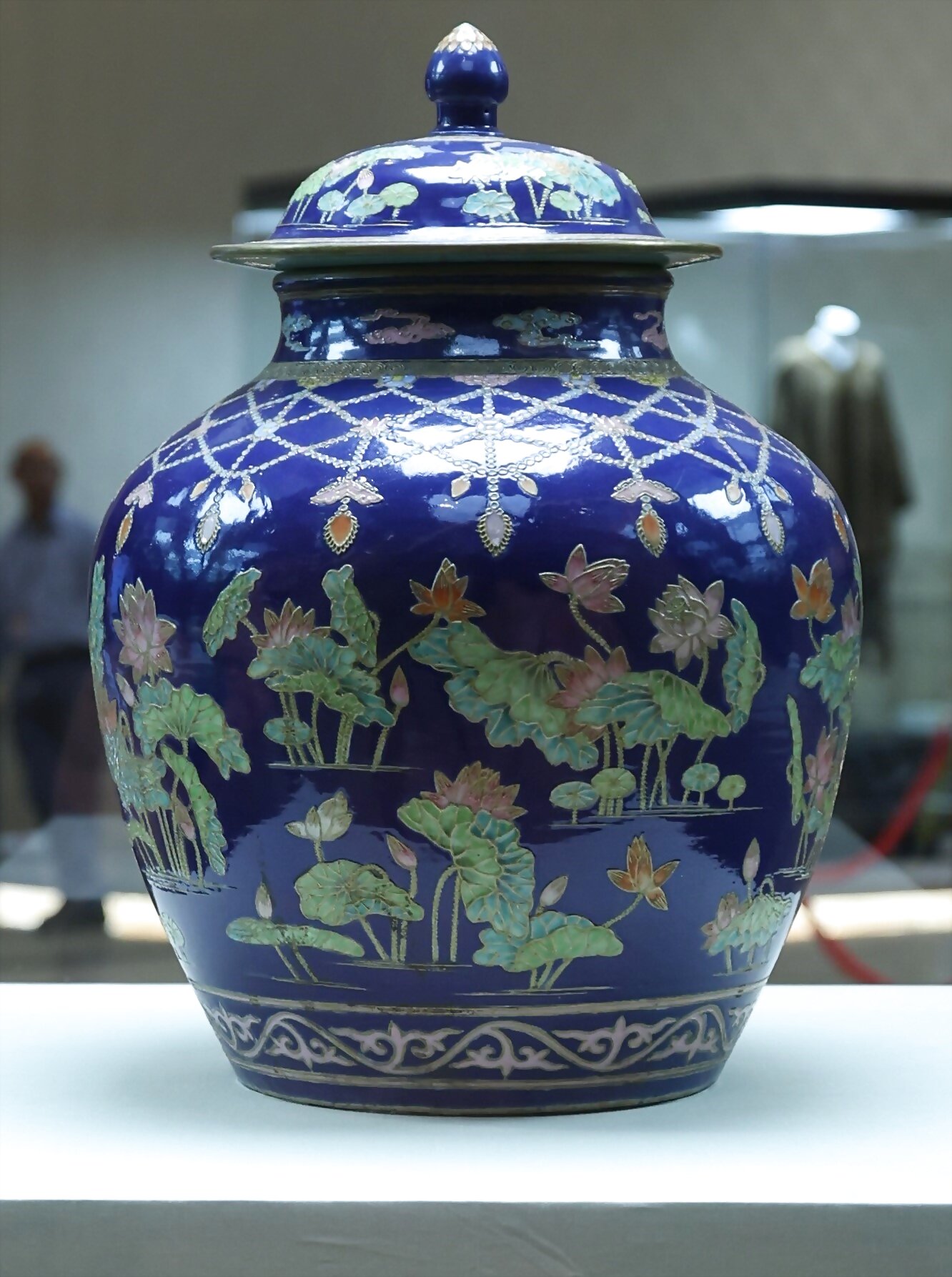
The design features vibrant green leaves and lotus motifs that infuse the scene with vitality. The yingluo (beaded chains) motif on the shoulder, symbolising “immeasurable light,” reflects awareness of a necklace that arrived with Buddhism from ancient India. This classically elegant jar emanates a refreshing aura due to meticulous craftsmanship.
VIDEO | "It is an exhibition of Digital India journey which aims to demonstrate the various milestones and projects of Digital India with the help of cycling," says Abhishek Singh, CEO of Digital India Corporation, on a stall installed at Bharat Mandapam, the venue of #G20Summit. pic.twitter.com/Brji9sjsCs— Press Trust of India (@PTI_News) September 8, 2023
EUROPEAN UNION: Marie Skłodowska-Curie (1867-1934)
This bronze statue was crafted by Berlin-based artist Anna Franzika Schwarzback as homage to eminent scientist Marie Curie. Recipient of two Nobel Prizes in her lifetime, Curie wielded science amid global strife, exemplified by her monumental work with the ‘Petites Curies’ that saved numerous lives during the First World War.
A Polish-born French citizen, Curie inspired several generations of scientists with her stellar body of work. Moreover, her scientific breakthroughs empowered women to pursue science in larger numbers, promoting a spirit of innovation that is deeply valued by the European Union.
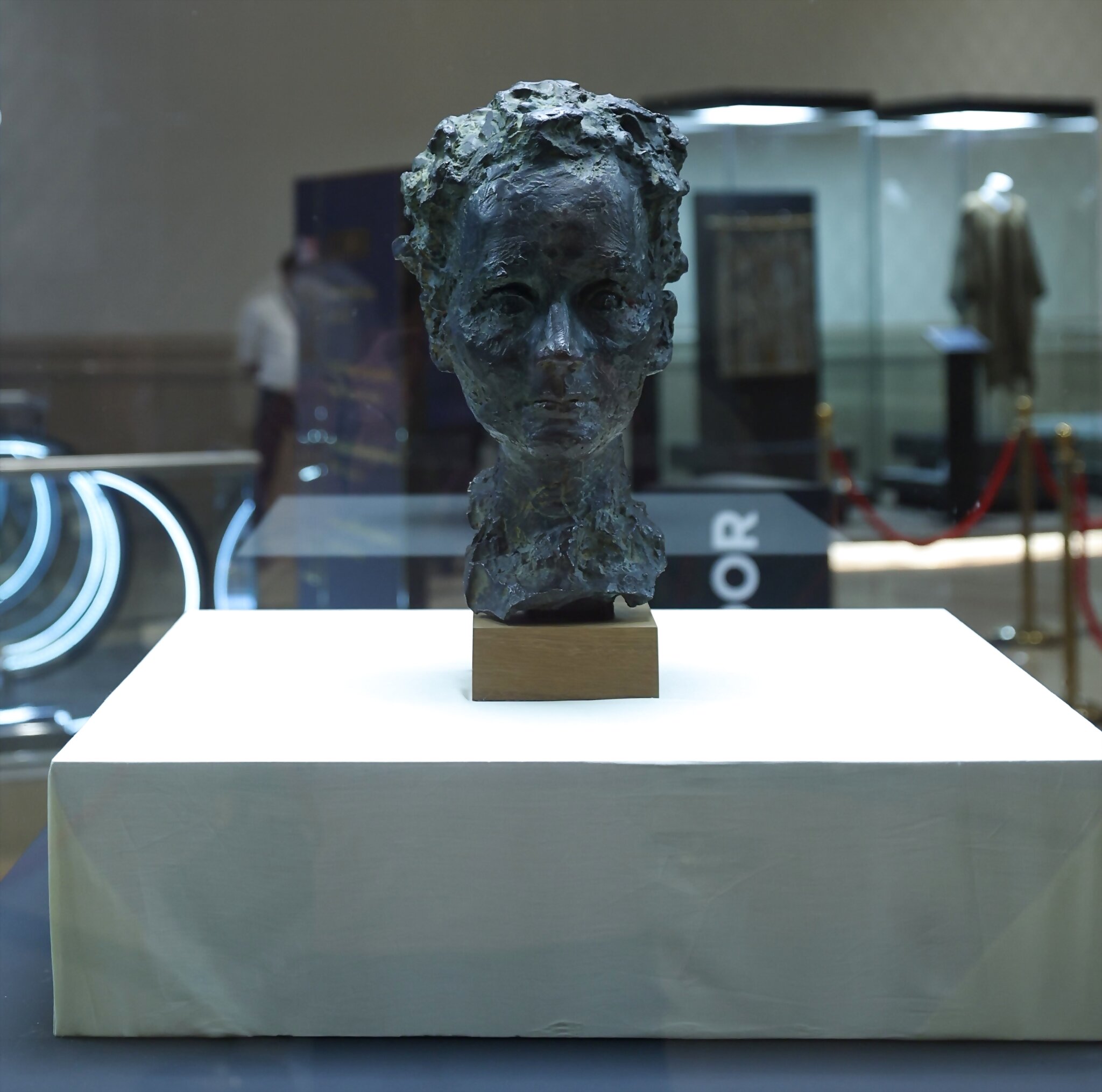
This statue, which has been exhibited in the main hall of Berlaymont in Brussels, captures Marie Curie’s unwavering commitment towards scientific pursuits. This sculpture is a tribute by the artist to Marie Skłodowska-Curie and to all women in science.
FRANCE: Auxerre vase with blue background and decoration of butterflies and trefoils
This 1912 Auxerre vase from Manufacture de Sèvres is crafted from “new porcelain,” innovated in 1875 for vibrant colours to compete with East Asian porcelain. With Sèvres blue and gold detailing, it exemplifies the manufacturer’s expertise.
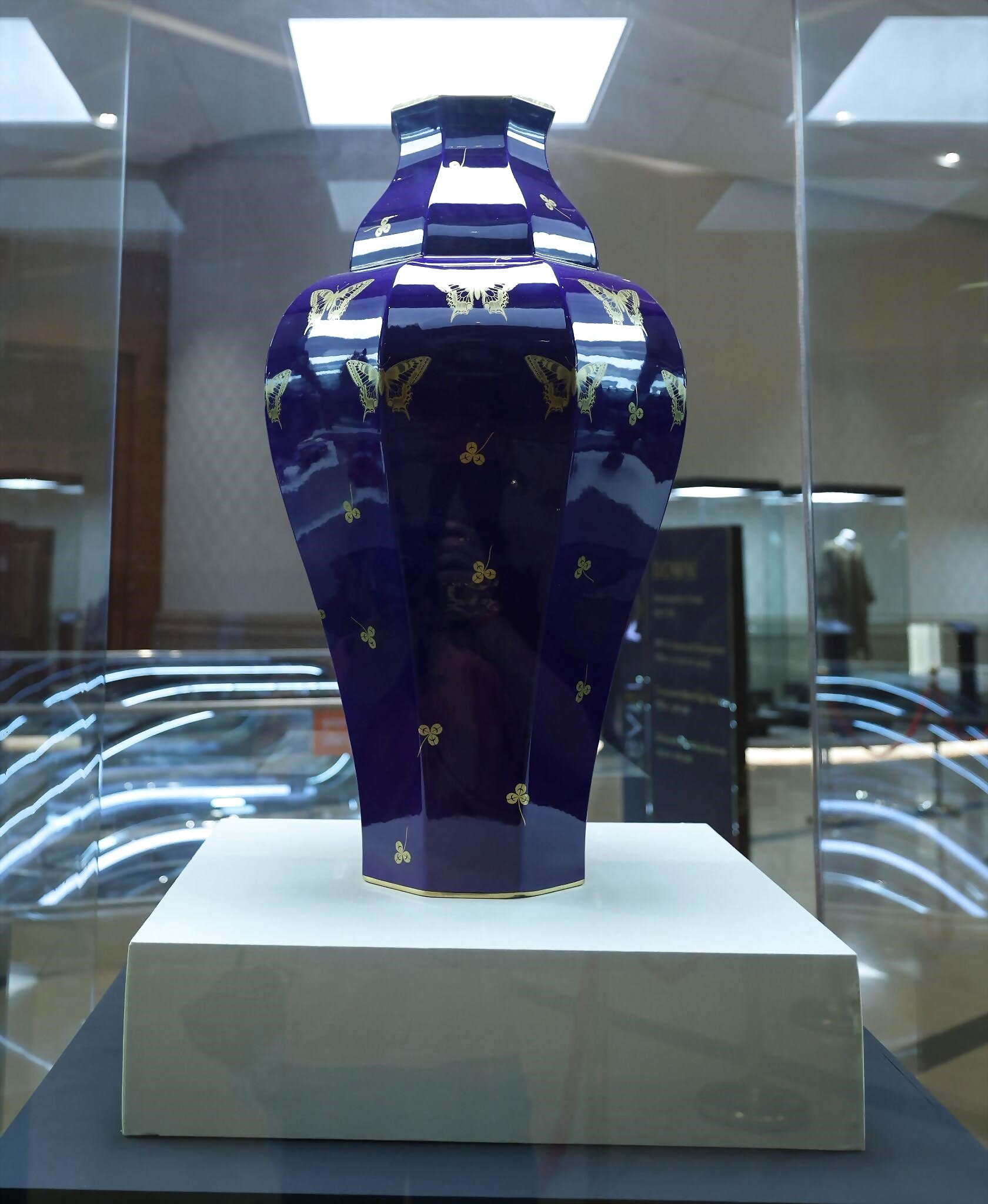
Designed by Alexandre Sandier, it is named after a small French town- Auxerre. This vase was deposited with the French Consulate in Geneva for promoting French culture for several years and has been recently returned to be exhibited at the G20 Leaders’ Summit in New Delhi.
GERMANY: VW Beetle miniature models
This miniature replica of the Volkswagen Old Beetle stands as an emblem of Germany’s engineering prowess. It is a tribute to automotive innovation in Germany, which is home to iconic brands like Volkswagen and BMW.

Affectionately known as the “Bug” or “Käfer” in German, the Old Beetle made a rollicking mid-20th-century debut with its distinct design, affordability, and reliability. Representing a shift in mobility, it left an enduring mark on family memories across the world. This 1:18 scale diecast model is a testament to meticulous craftsmanship, faithfully mirroring every curve and detail of the original. It serves as a symbol of innovation, a journey through time, and a nostalgic reflection of a bygone era.
ITALY: Belvedere Apollo
This bronze statuette crafted by Renaissance sculptor Jacopo Bonacolsi, depicts Apollo Belvedere. It is inspired by a Roman marble sculpture uncovered during the 15th century in central Italy. Once housed in the Vatican Palace and now within the Vatican Museum, it epitomizes the ideal of beauty from the Renaissance period through to the 18th century.
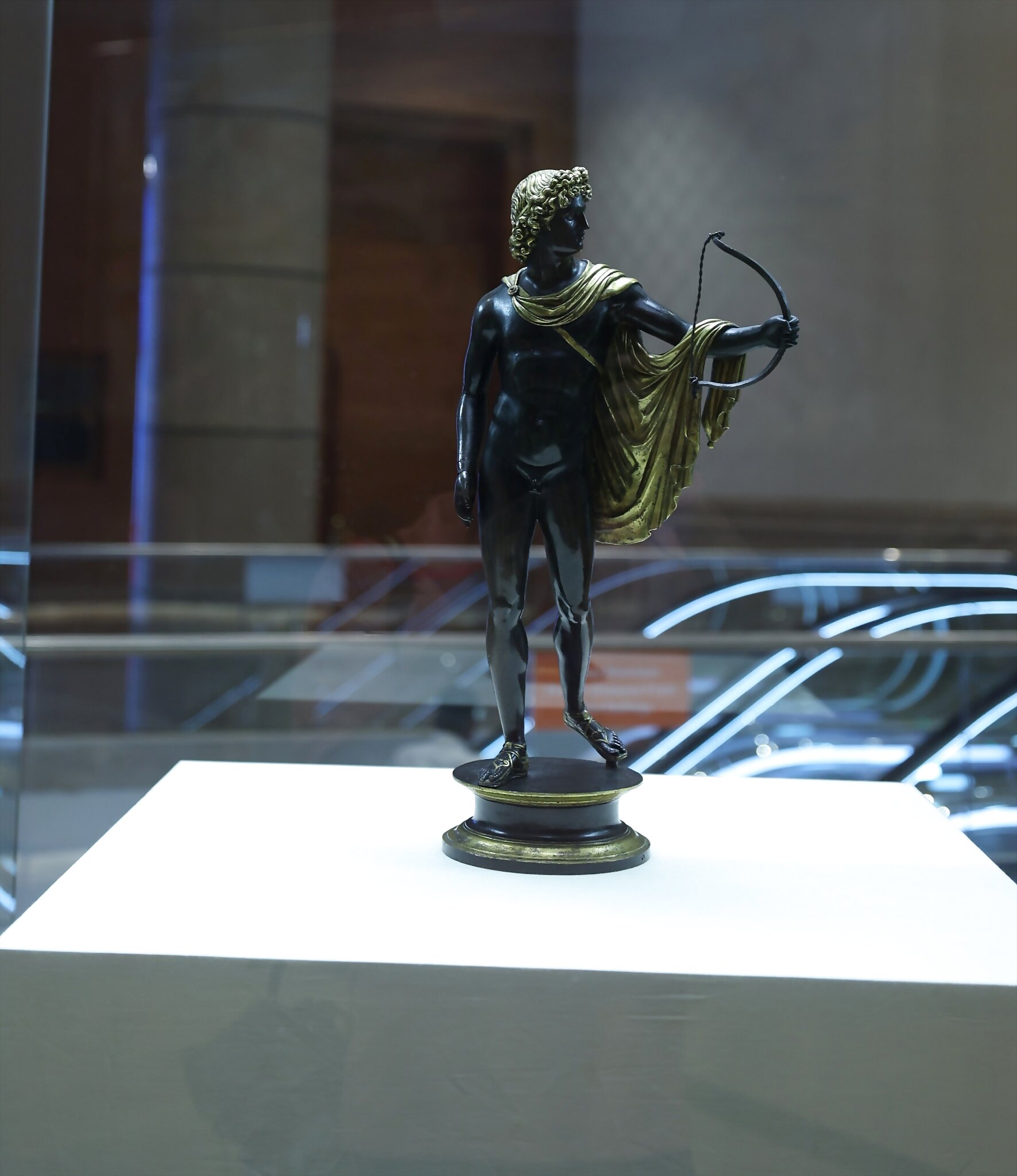
For several centuries, artists drew inspiration from this ideal portrayal of human body. The small size of Apollo reflects Bonacolsi’s endeavor to capture an intimate yearning for universal harmony, of which Apollo is considered the patron deity. The hallmark of Renaissance art is returning to antiquity and evoking universal harmony.
JAPAN: Nendoroid Hatsune Miku: Kōrin Kimono Version and Kosode (Garment with small wrist openings)
The Nendoroid Hatsune Miku figurine emerged from the Kōrin Kimono Restoration Project. Crypton Future Media INC’s Hatsune Miku software turns melodies and lyrics into her voice, giving her immense global popularity. Beyond mascot duty, she stars in music and merchandise, even concerts.
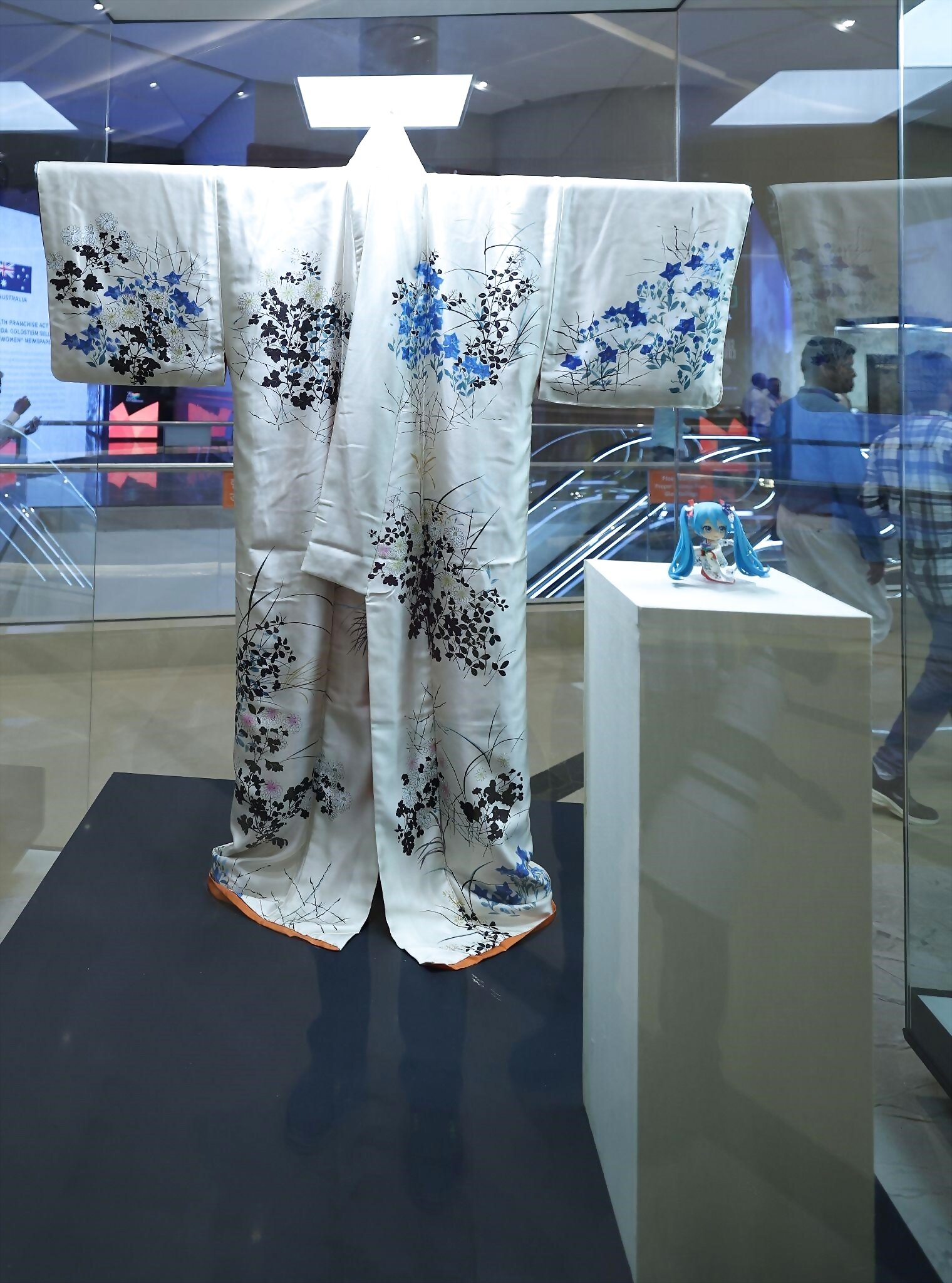
This figurine is clad in a 300-year-old Kōrin Kimono that was designated as an important cultural property by the Japanese government in 1971. Tokyo National Museum and National Center for Cultural Properties launched the Kōrin Kimono Restoration in 2020, backed by a fundraiser that has yielded 16 million yen. Nendoroid Hatsune Miku’s wide appeal is undeniable, bridging cultural heritage and modern fandom.
REPUBLIC OF KOREA: The Artisan-Crafted Hat, Gat and Headpiece, Jokduri
Korea, hailed as the ‘land of hats,’ boasts an array of traditional headwear. The Gat refers to a black hat worn by men during the Joseon dynasty (1392-1910). Rooted in ancient times and having undergone variations over time, the Gat has historically functioned as a marker of social status. The Jokduri is a formal women’s headdress, with the extent of decoration varying depending on the context— plain for rites, gem-encrusted black silk for weddings and so on.
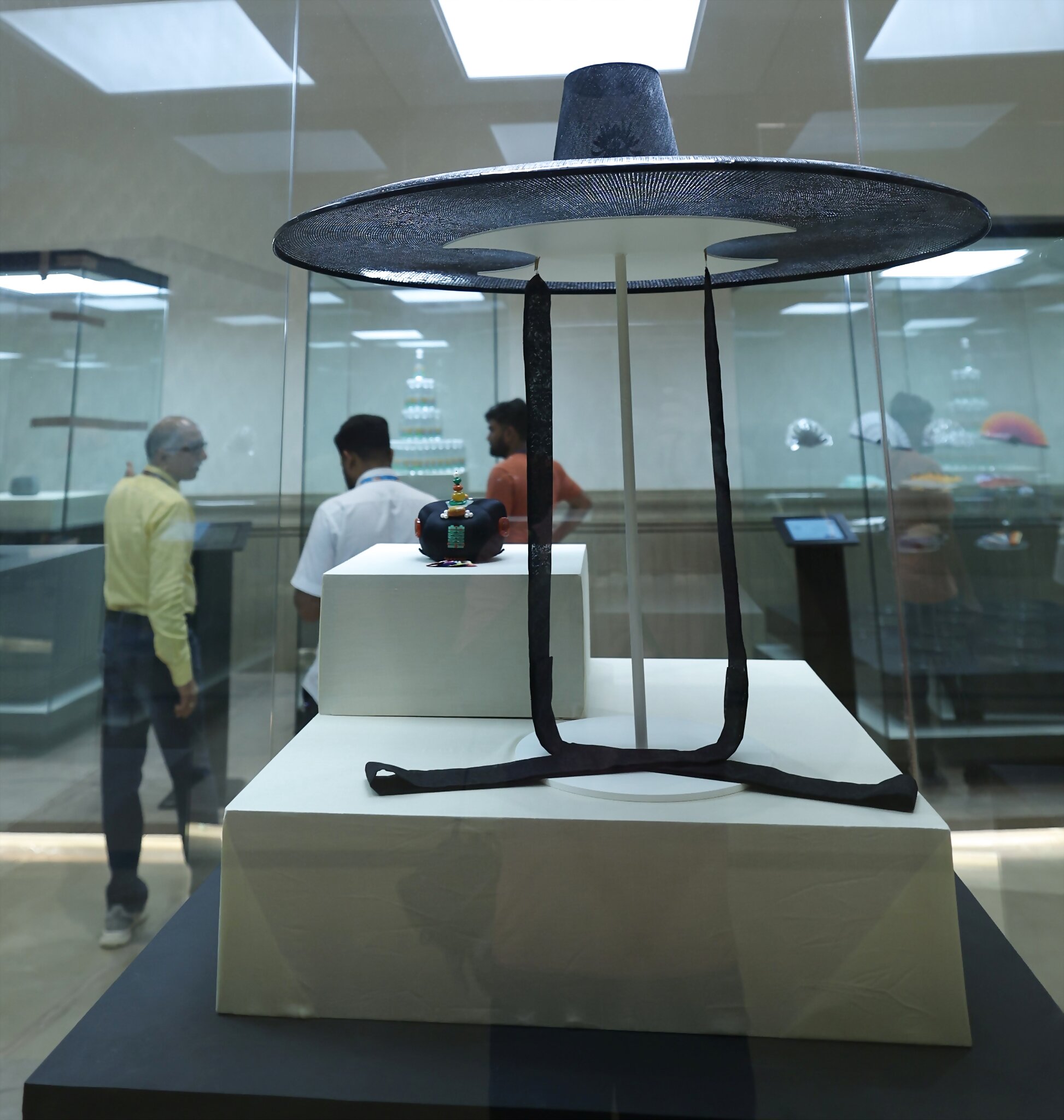
The Jokduri embodies the dignity of Korean culture by gracefully integrating grace with splendor. Traditional Korean attire-including the Gat and Jokduri has acquired unprecedented global recognition through films and drama series. Korean pop culture has been taking noteworthy efforts to reimagine traditional techniques in modern idioms.
MEXICO: Sculpture of Duality: Quetzalcoatl (feathered serpent god) and Tlaltecuhtli (goddess of the earth)
This is a remarkable representation of two pivotal figures from Aztec mythology — Quetzalcoatl, the feathered serpent God, and Tlaltecuhtli, the earth Goddess. According to an ancient legend, the earth was created when the Gods brought down Goddess Tlaltecuhtli from heaven. Tlaltecuhtli’s destructive tendencies led to divine punishment, as her body was torn apart to form the earth and the sky.
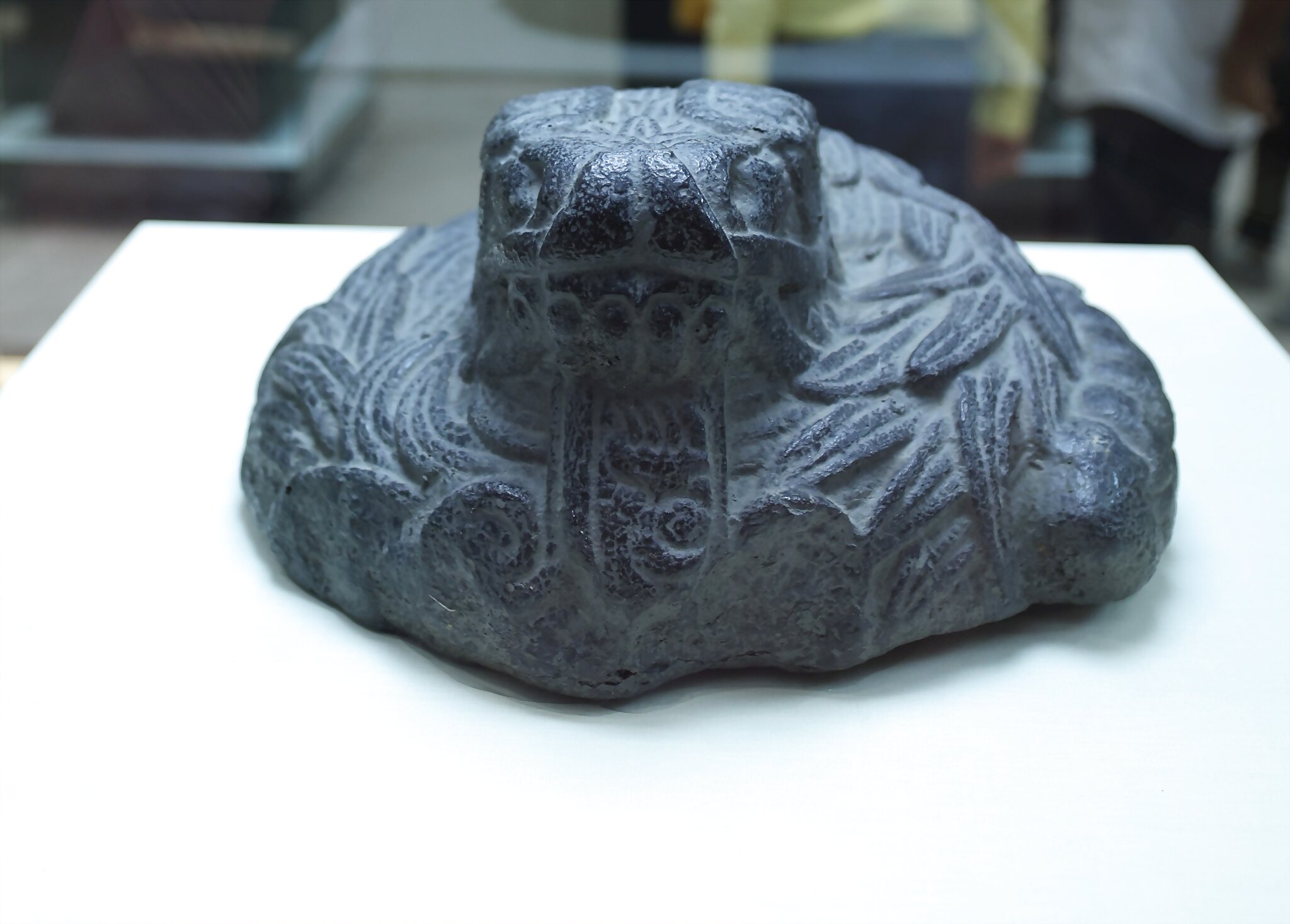
The intricate designs on the sculpture reveal the unknown artist’s exceptional skill, capturing the essence of creation. One side of the sculpture reveals Tlaltecuhtli, while the other depicts Quetzalcoatl, adorned with symbolic motifs reflecting growth and promise. The sculpture exemplifies the rich mythological heritage of the Aztec civilization.
RUSSIA: Traditional Khakass women’s Dress, vest And Pogó
This is a traditional Khakass woman’s attire adorned with a pogo — a hemispherical embellishment on the wedding breastplate. Pogó features beads, buttons, pearls, and cowry shells, symbolizing fertility and prosperity in Khakass culture. Archaeological findings from the ancient Khakass region trace back the use of breastplate to the Bronze Age.
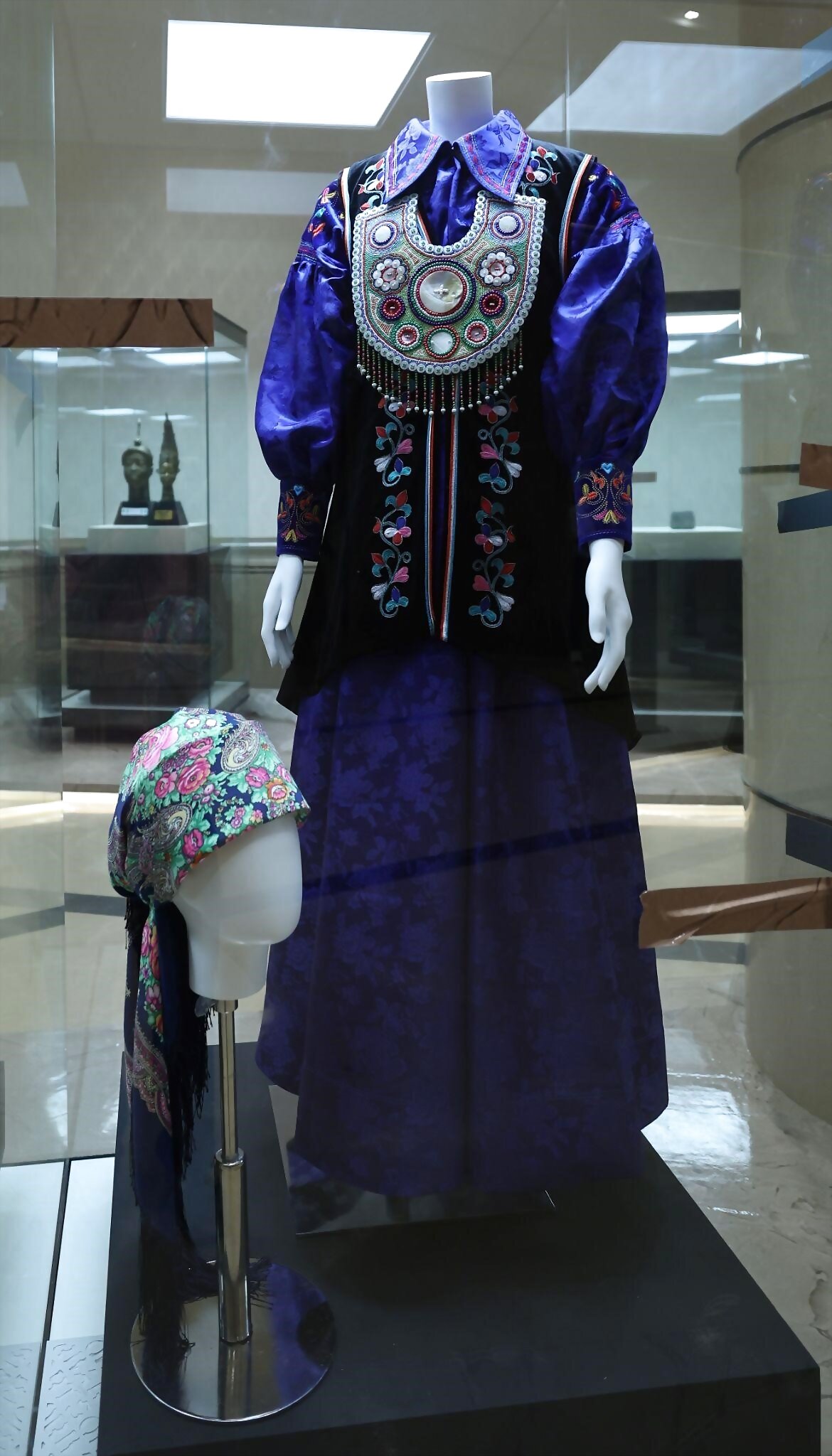
During the Middle Ages, Ymai, the goddess of fertility, gained reverence. Pogó’s symbol is interwoven with Khakass marriage rituals. The goddess image gracing the pogo is believed to bless unions and safeguard families. This female breastplate showcases Khakassia’s artistic and technological progress, reflecting cultural depth and the legacy of goddess-inspired customs.
SAUDI ARABIA: Tayma Stele with Aramaic Inscription
This 6th-century BCE Tayma Stele bears a ten-line Aramaic inscription and a striking religious tableau. It recounts the appointment of a priest in the temple of the god Salm, also mandating other temples to offer a harvest of twenty one palm trees to the same deity.
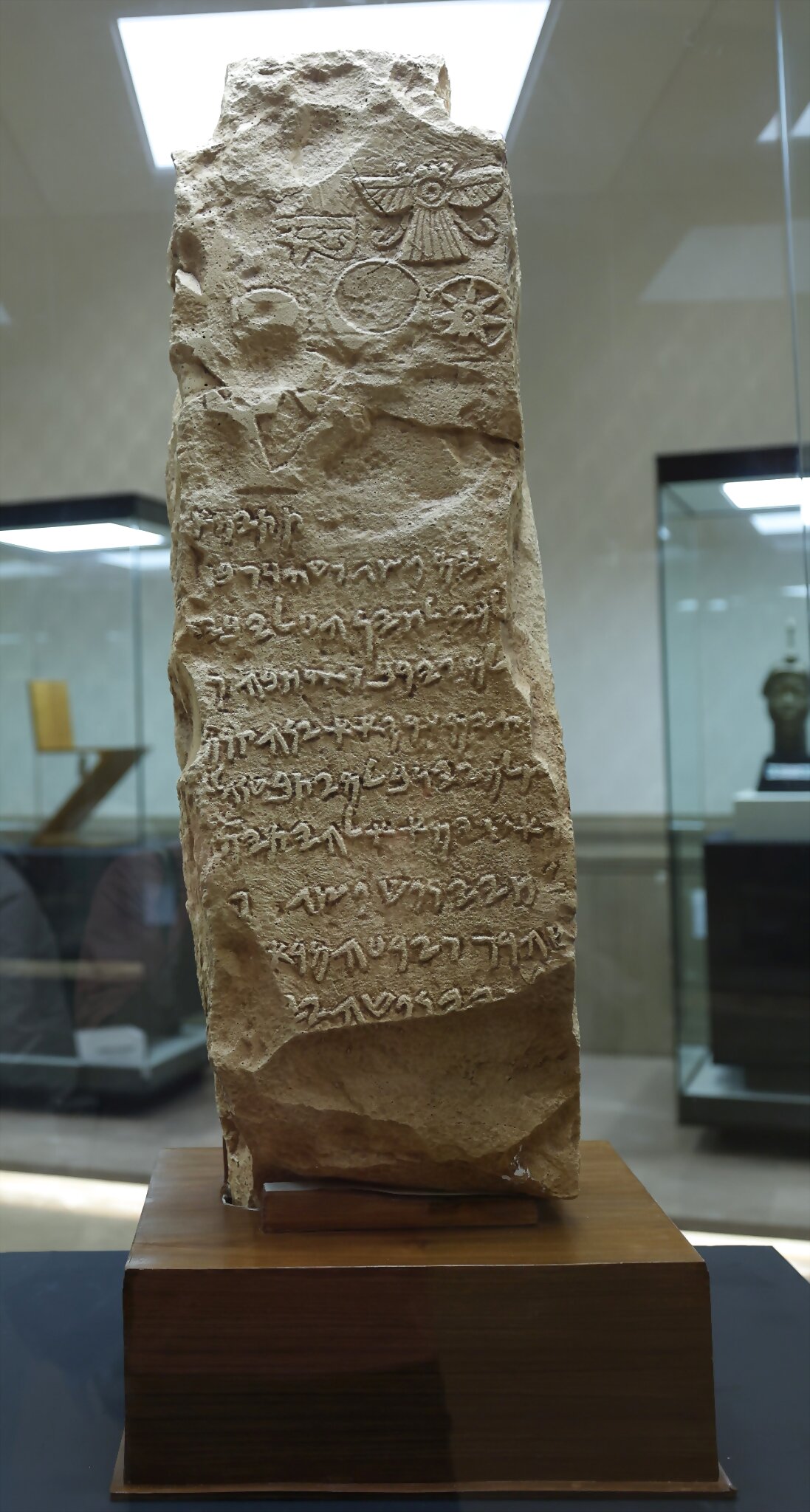
Tayma, situated about 264 kilometers Southeast of Tabuk, is a historic oasis renowned for abundant archaeological sites spanning prehistoric and Madinian eras. Relics from the 6th century BCE and early Islamic times, including inscriptions and artefacts, have been found in this region. Landmarks like the Great Wall, Al-Hamra Palace, Haddaj Well, Al-Ablaq Palace, and Al-Bujaidi Palace dot this historic landscape.
SOUTH AFRICA: A cast of Australopithecus Africanus (Mrs. Ples)
Australopithecus Africanus, known as Mrs. Ples, is one of the earliest hominins to be recorded in archaeological annals. Dr. Robert Broom discovered this specimen in 1947, and subsequently it was dated to over 2.5 million years ago.
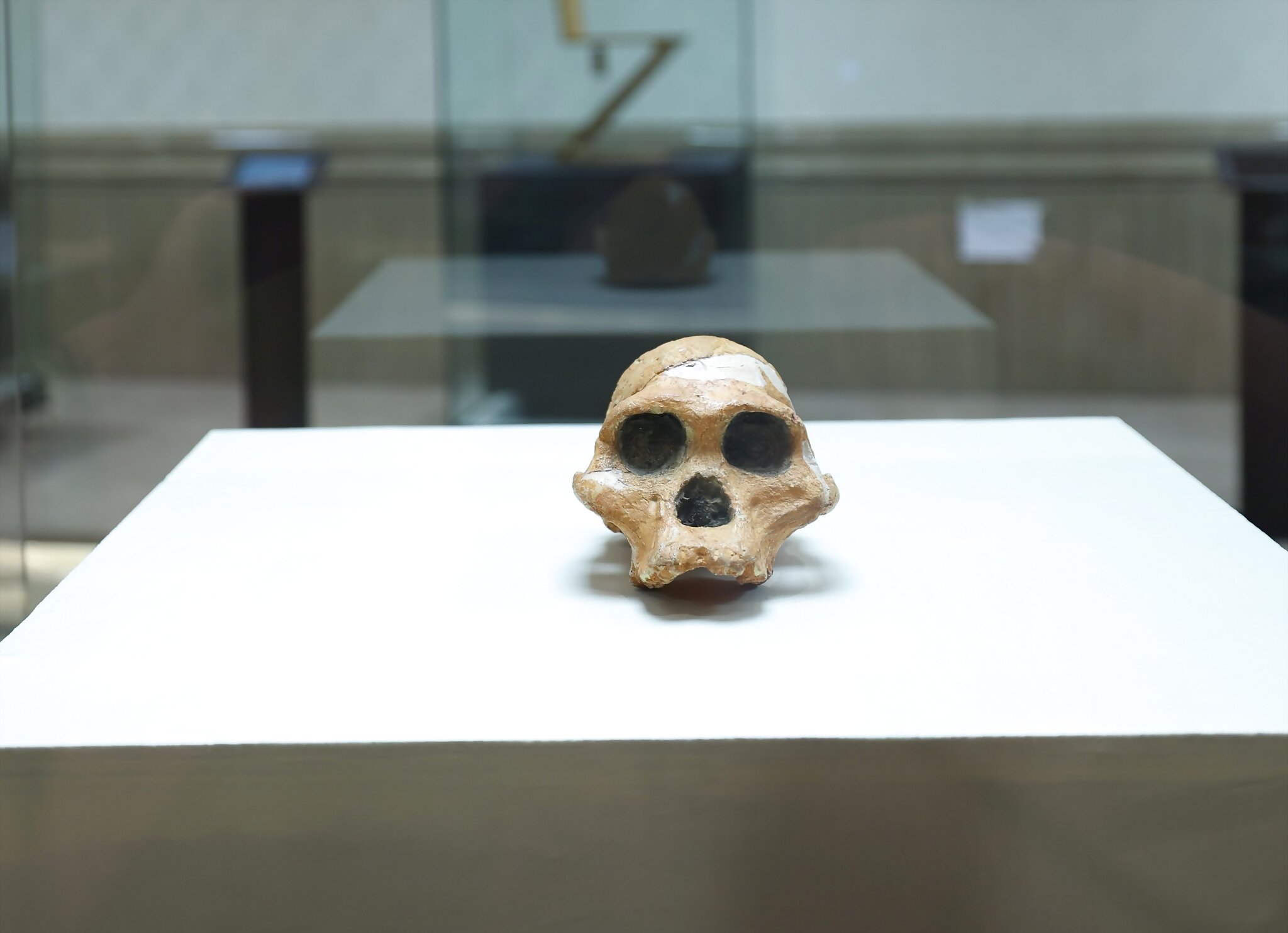
The specimen’s prominence lies in its skull, with potential links to a juvenile skeleton nearby. In South Africa, Australopithecus encompasses the species of Australopithecus prometheus (Little Foot), Australopithecus Africanus (Mrs. Ples and Taung Child), Paranthropus Robustus, and Australopithecus Sediba (Karabo).
This dense paleontological heritage solidifies Africa’s position as the cradle of humanity. The words of esteemed paleoanthropologist Prof. Phillip Valentine Tobias encapsulate it: “Africa gave the world humanity.”
TURKIYE: Göbekli Tepe Stele
This is a modern glass replica of a T-shaped limestone pillar that supported some monumental megalithic structures in Upper Mesopotamia. These structures were built by communities that were negotiating the momentous Neolithic transition- from hunting-gathering to agricultural production.
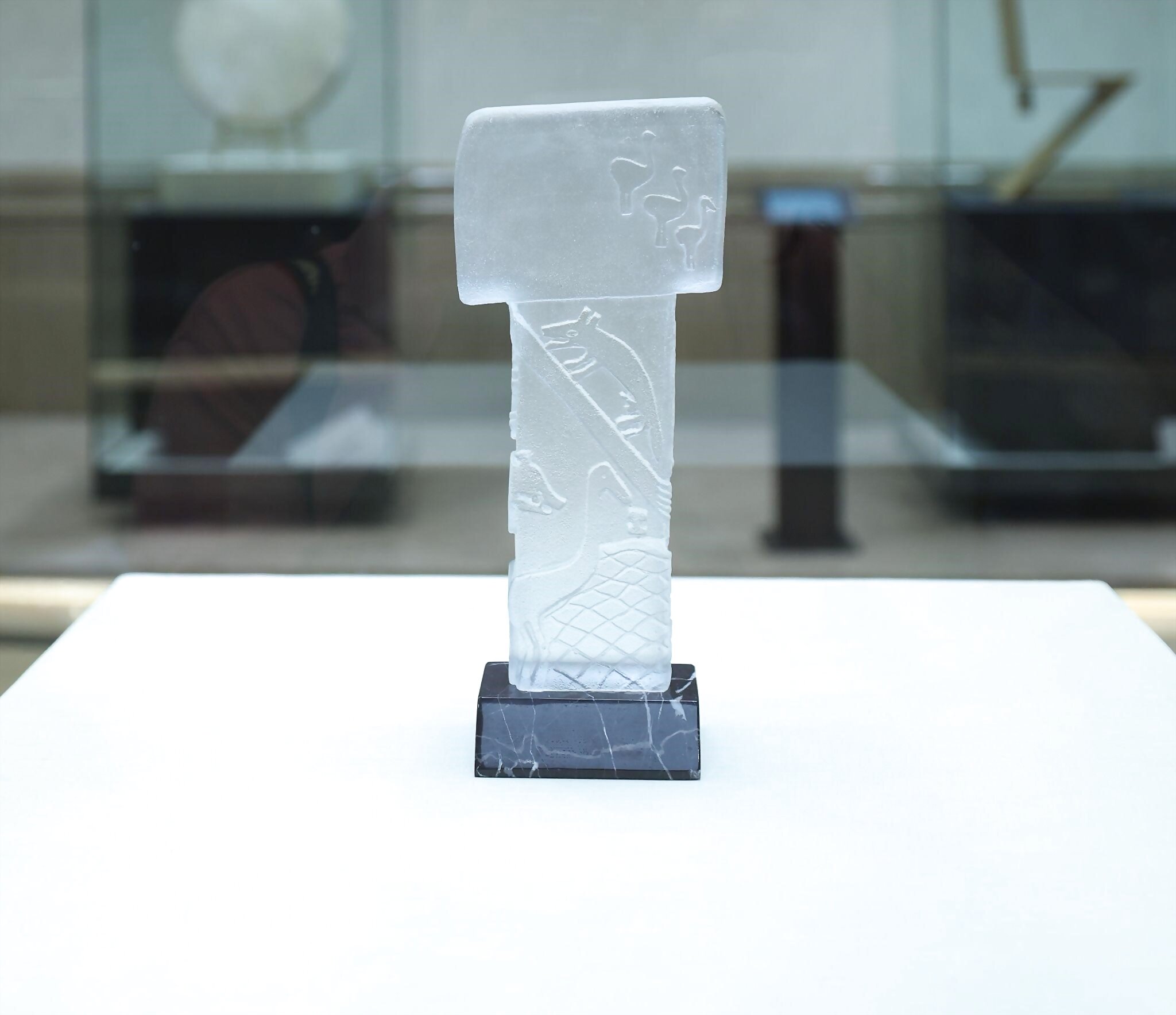
The innovative designs embedded on the T-pillars attest to the presence of specialised craftsmen in this region. Adorned with totemic art — wild boars, vultures, geese — that is similar to the imagery found in other sites, these pillars reflect vibrant networks of socio-cultural exchange. Artefacts from sites like Göbekli Tepe are housed in the Şanlıurfa Archaeology and Mosaic Museums.
UNITED KINGDOM: Full-size colour reproduction of the entire original document, Magna Carta
The Magna Carta or the ‘Great Charter’ is one of the most celebrated documents in the history of the United Kingdom. Although its original composition in 1215 had political undertones, the Magna Carta radically reconfigured the relationship between the king and his subjects, by establishing the rule of law.
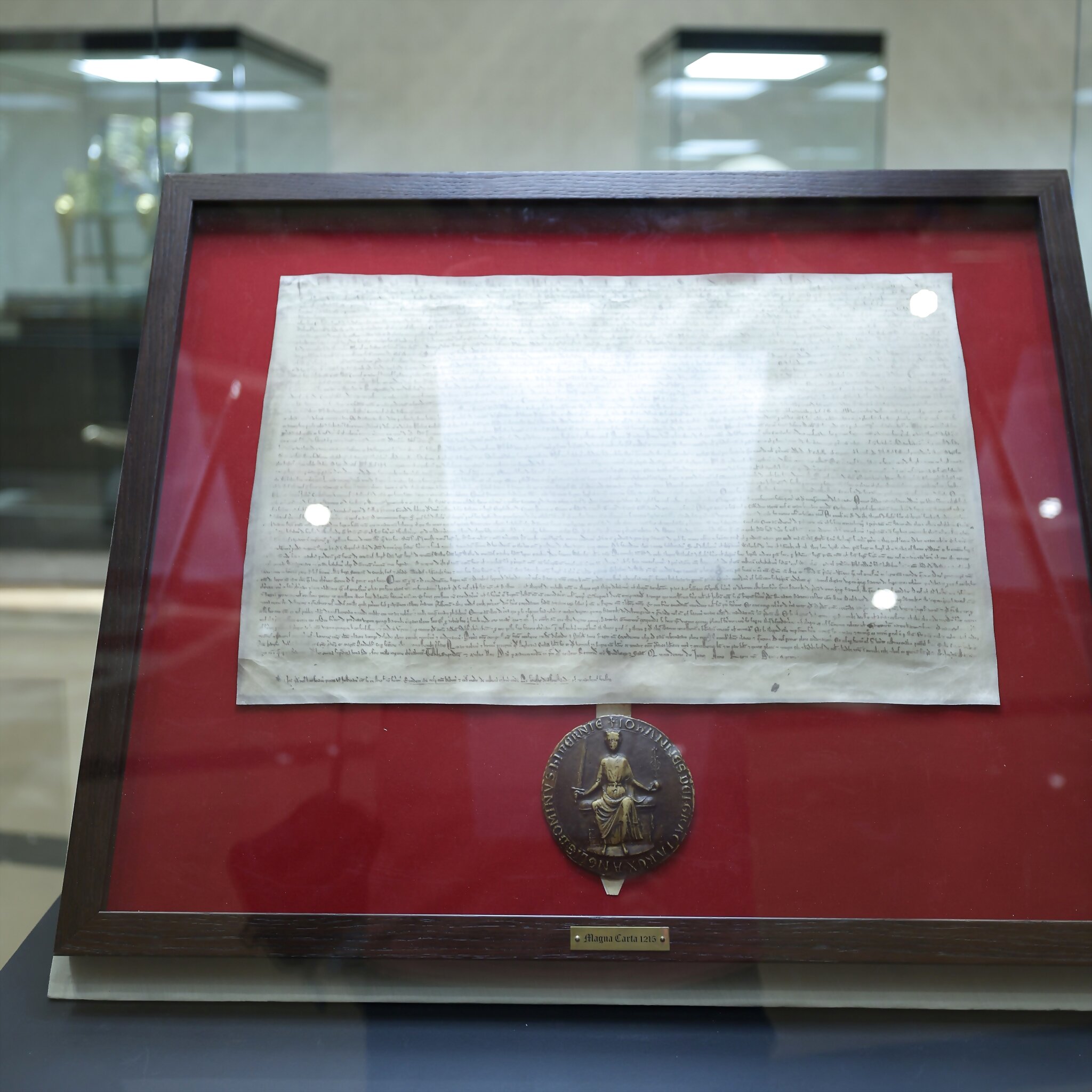
The 1225 version of the Magna Carta- issued by Henry III- became its definitive version. It initially contained 63 clauses, and three persist in English law. One defends the liberties of the English church, another confirms the liberties of London and other towns, and the third, most significantly, gives all free men the right to justice and a free trial. Though many of its clauses are obsolete, the Magna Carta’s enduring significance lies in its symbolic role — laying the groundwork for democracy in England.
USA: Tyranny of Mirrors
The ‘Tyranny of Mirrors’ is a notable piece from the Codex series, initiated by New-York-based conceptual artist Sanford Biggers. Over the past two decades, this series has used antique quilts to spark cross-cultural conversations in the realm of contemporary art. In this painting, Biggers employs three-dimensional cubes that appear in motion, creating the illusion of tumbling blocks.
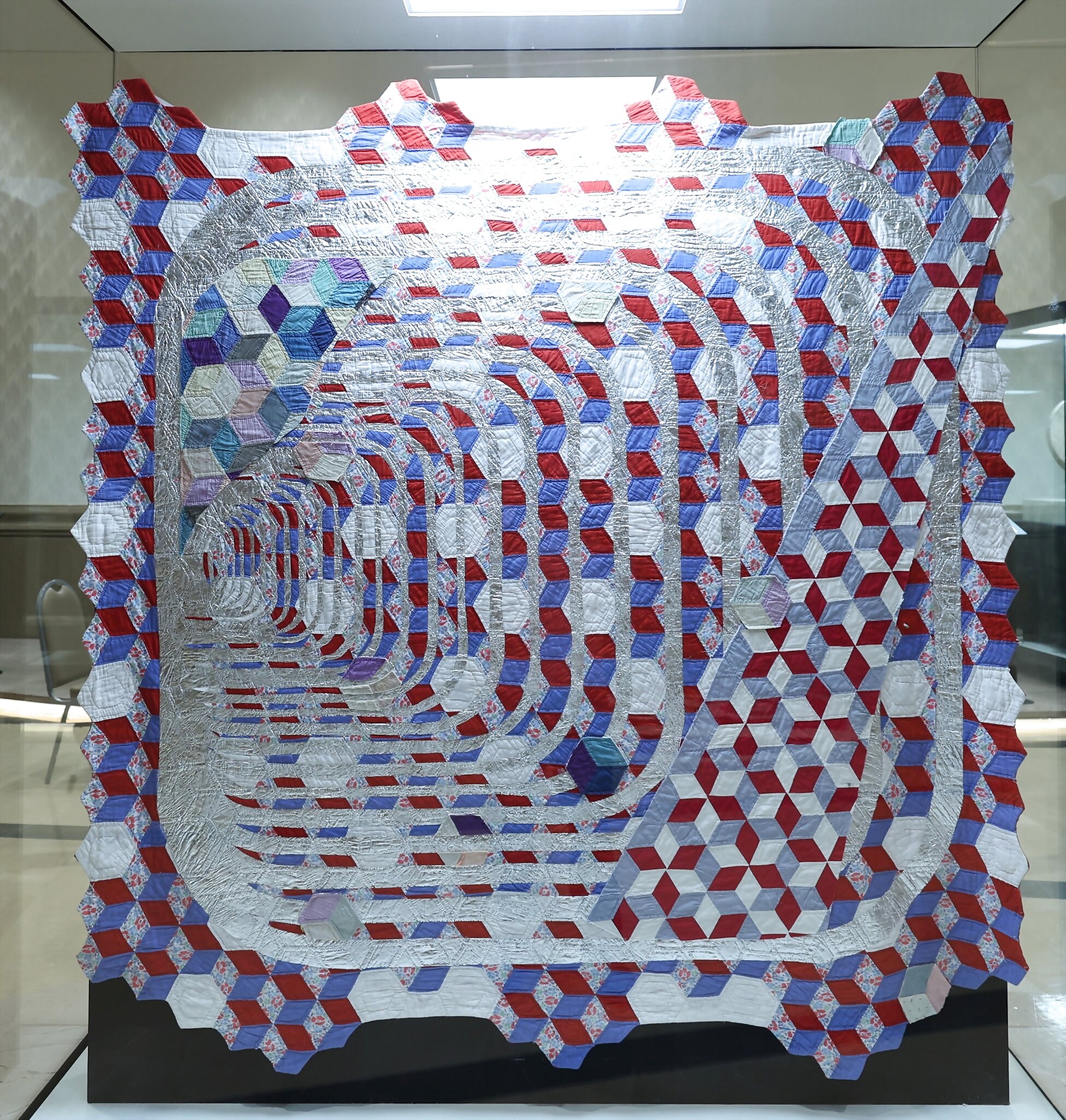
This is theorised as a metaphor for safe escape routes on the Underground Railroad, potentially enabling people to evade pursuers. This reflects the artist’s recognition of the strategic significance of quilts as signposts on the Underground Railroad, imbued with messages to guide people towards freedom. A diverse spectrum of references can be discerned in Bigger’s works, including jazz, astronomy, Buddhism, sacred geometry, mythology, and symbolism, among many others. His work, therefore, embodies beauty, precision, and open-ended contemplation, seamlessly weaving a tapestry of cultural elements from around the world.
BANGLADESH: Bust of Sheikh Mujibur Rahman
Bangabandhu Sheikh Mujibur Rahman (1920-1975), also known as the Father of the Nation of Bangladesh, was born on March 17, 1920, in Tungipara village, Faridpur district. The third child of Sheikh Lutfur Rahman and Sayera Khatun, his parents fondly called him Khoka. He married Begum Fazilatunnesa at 18 and completed studies at Calcutta Islamia College. An unwavering advocate for Bengali interests, he founded the Awami League and championed the sixpoint movement in 1966. Arrested in the Agartala conspiracy case, he emerged stronger, triggering a mass uprising in 1969.
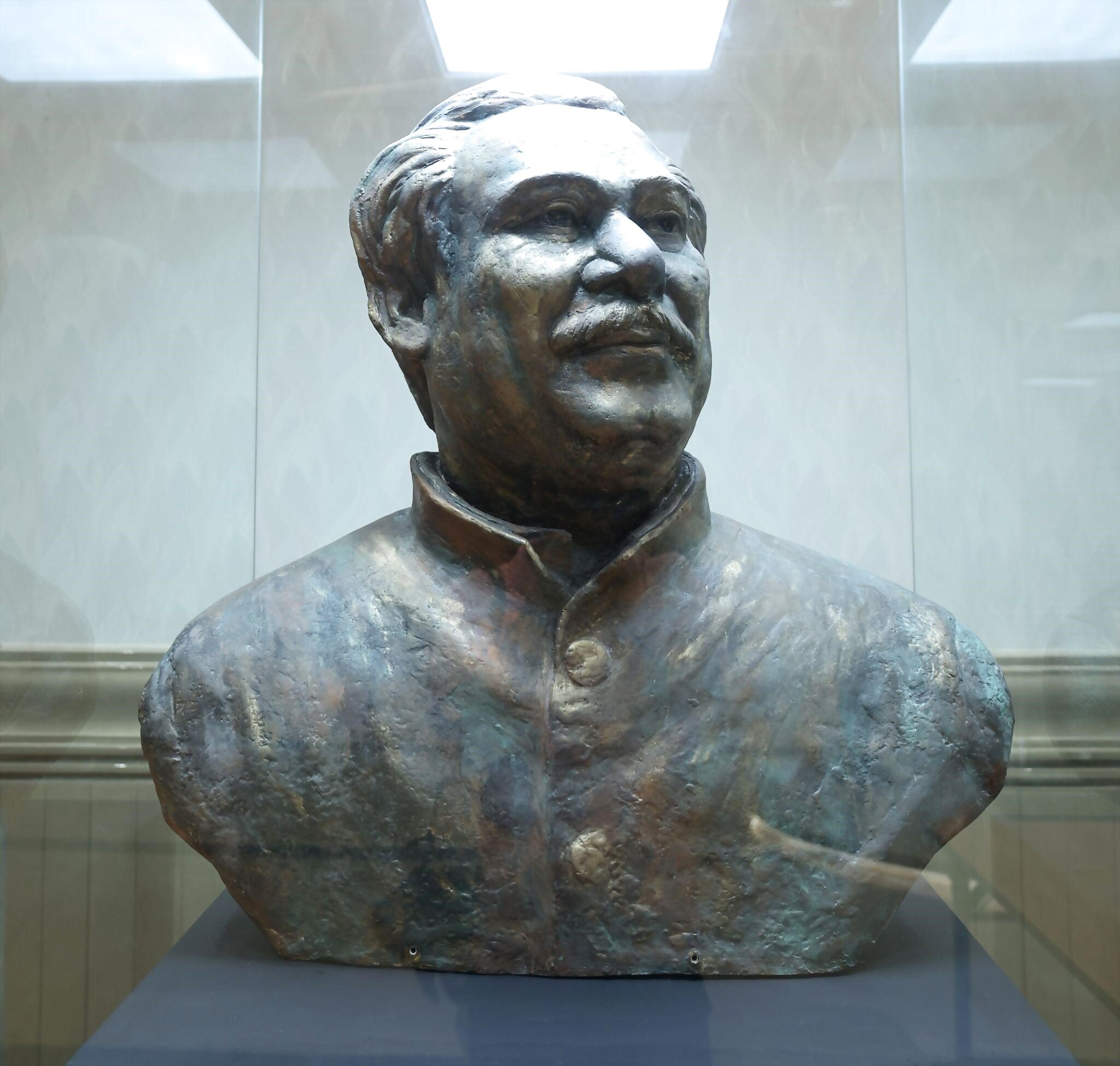
Dubbed “Bangabandhu” (Friend of the Bengalis), he led East Pakistan’s movement for autonomy. His historic March 7, 1971 speech marked a turning point, as he demanded emancipation and independence. Amid brutal crackdowns and refugee crises, he spearheaded Bangladesh’s struggle for freedom. In 1972, he became the nation’s first President. Tragically, he was assassinated on August 15, 1975.
EGYPT: The Golden Mask and modern ceremonial chair of King Tutankhamun
King Tutankhamun became one of the most iconic figures in Egyptian history after the discovery of his tomb in the Valley of the Kings. The mask on display shows Tutankhamun resembling Osiris, the God of the afterlife. It was intended to protect the face and head of the mummy through a magic formula engraved on the back.
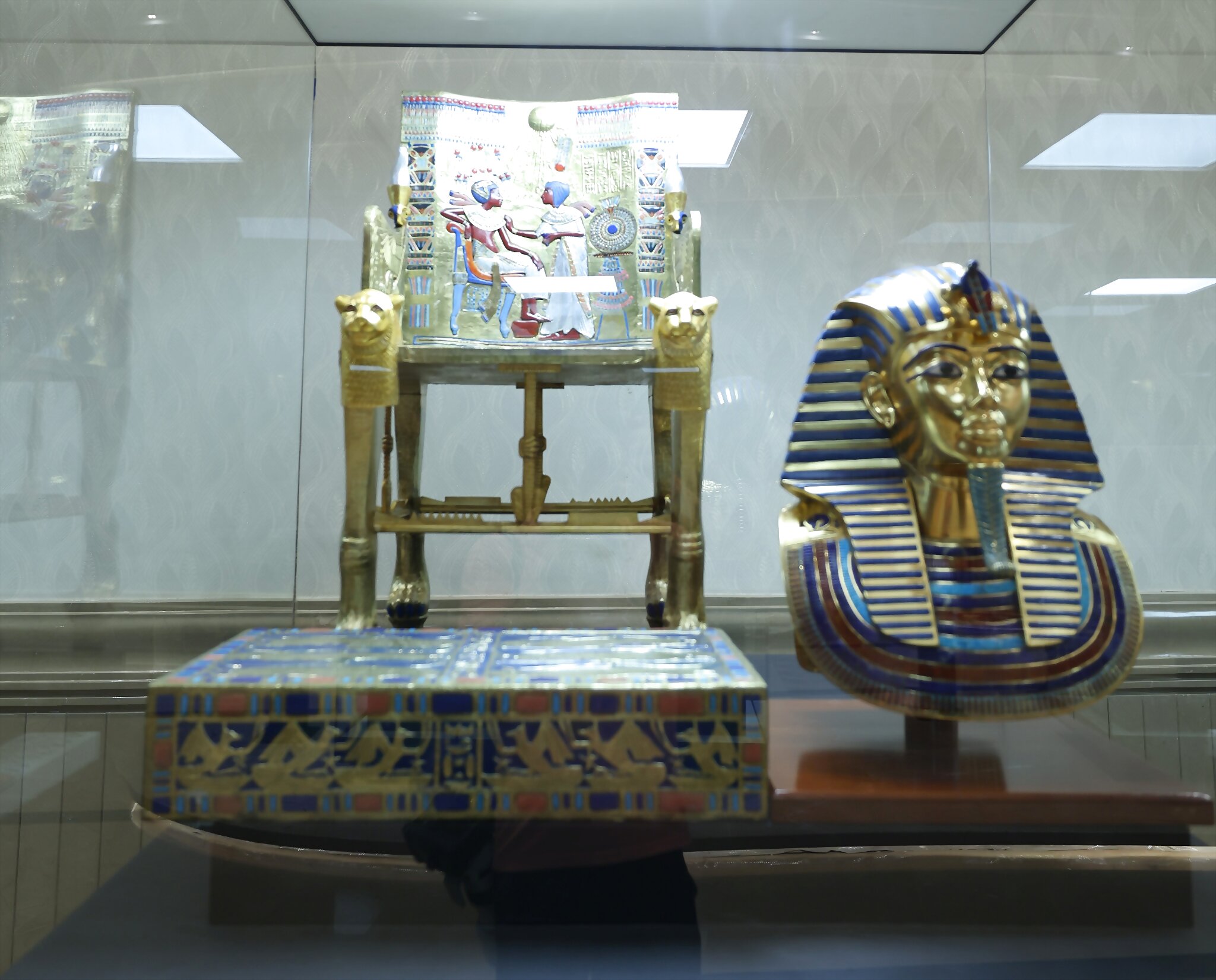
The golden throne, which was discovered in his tomb, shows both the king and the queen under the rays of the solar disk, decked in elaborate headdress and jewellery. This reflects the extravagance of royal life, as well as the pre-eminence of the sun god in the Egyptian pantheon. It also signifies the assumption of divine authority by the King. The mask and the throne reveal the stellar artistic and technical achievements of ancient Egyptians in the New Kingdom.
MAURITIUS: Ravann
Ravann is the core instrument in traditional Mauritian Sega. Sega is one of the major musical genres of Mauritius. It is historically intertwined with slavery, allowing oppressed individuals to convey their dehumanising experiences through collective expression. Crafted from wood, aloe leaf cords, tamarind berry glue, and goat’s skin, it embodies generations of Mauritian knowledge traditions. Its round shape features a heated, circular wooden piece called ‘tour,’ that produces pulsating, captivating beats.
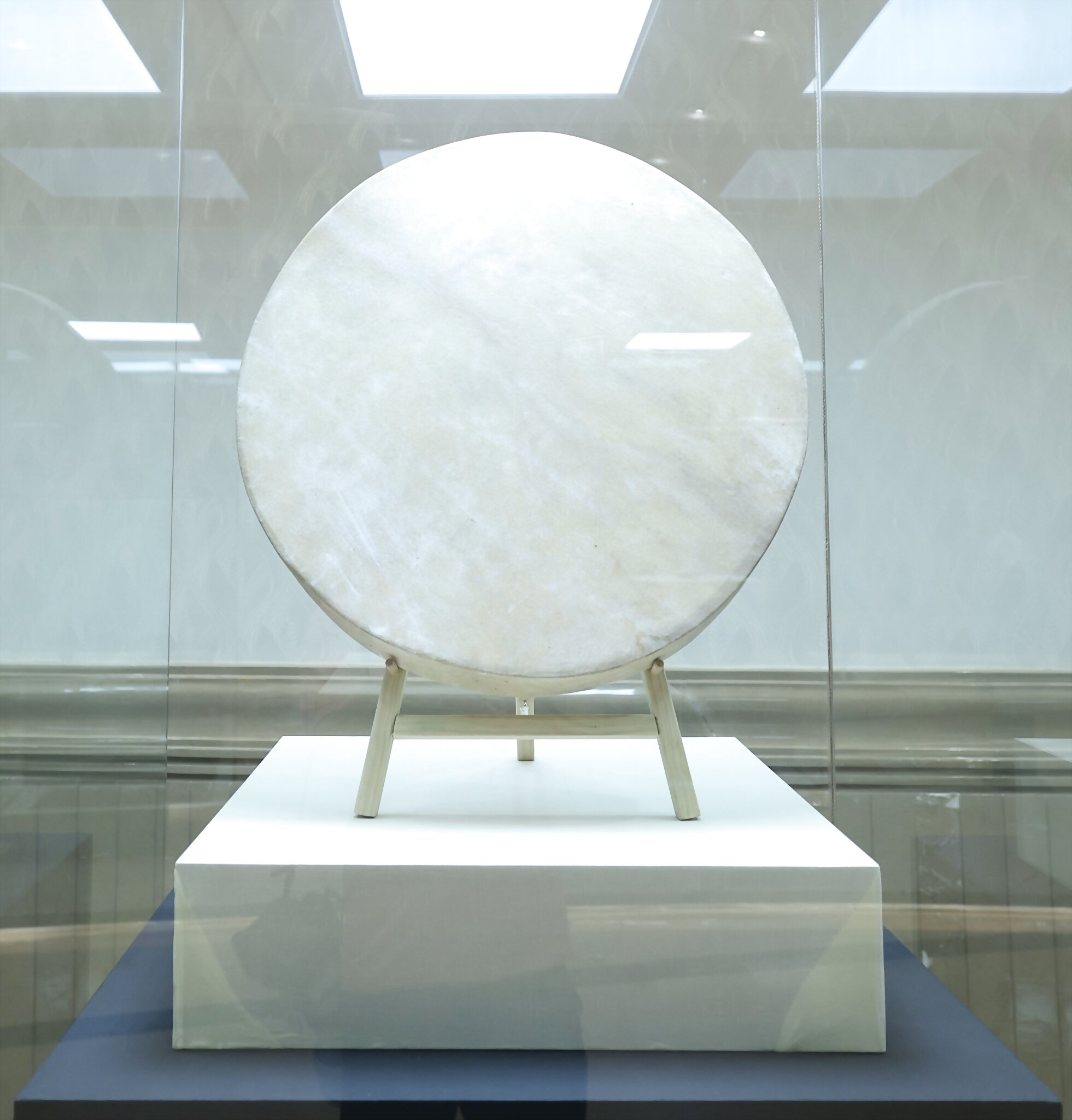
The Ravann’s music acts as a unifying element, bridging diverse backgrounds and anchoring itself in Mauritius’ cultural legacy. Recognised on UNESCO’s Representative List of Intangible Cultural Heritage of Humanity, the Ravann symbolises community resilience, thriving intergenerational heritage, and the enduring power of music.
NETHERLANDS: Zig-Zag Chair
This zig-zag chair was conceived by the renowned Dutch architect and designer Gerrit Rietveld (1888-1964). It embodies his pursuit of simplicity and accessibility, devoid of unnecessary adornments. Constructed from only four wooden planks, the chair impeccably merges form, function, and construction. Rietveld belonged to the Dutch De Stijl movement, advocating minimal colors to produce compelling, uncomplicated designs.
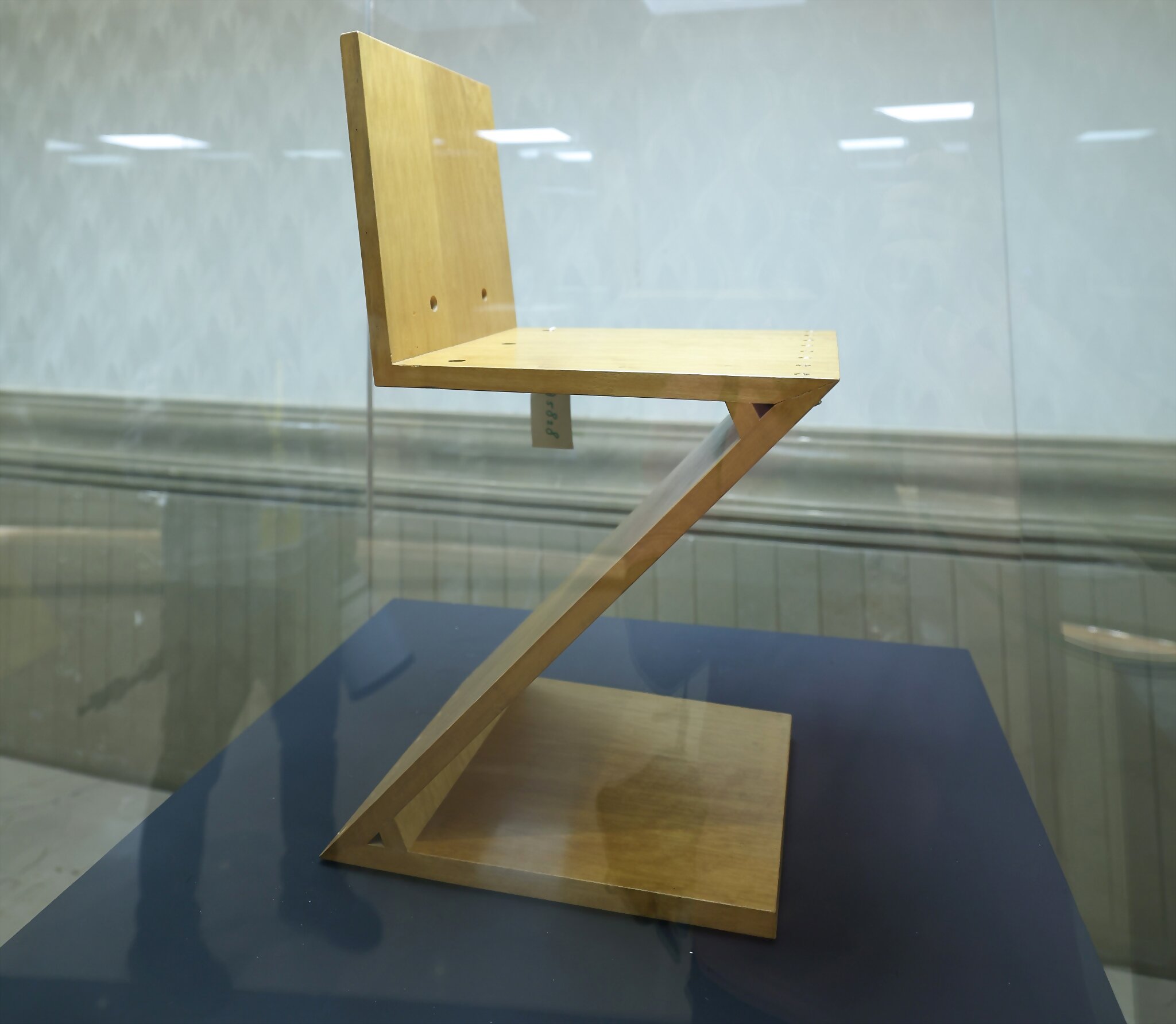
This ethos endures in modern Dutch design, recognized for its minimalist, innovative, and unconventional nature. Rooted in sustainability and an audacious sense of humor, Dutch design never fails to captivate the imagination. The iconic zig-zag chair exemplifies some transcendent principles that characterise the Dutch aesthetic tradition.
NIGERIA: Head of Queen Idia and Male Head from Ife
The Bronze Head of Queen Idia is a medieval Benin artifact, portraying Queen Idia, who supported her son’s ascent to the Benin throne (1504-1550) through unwavering efforts.
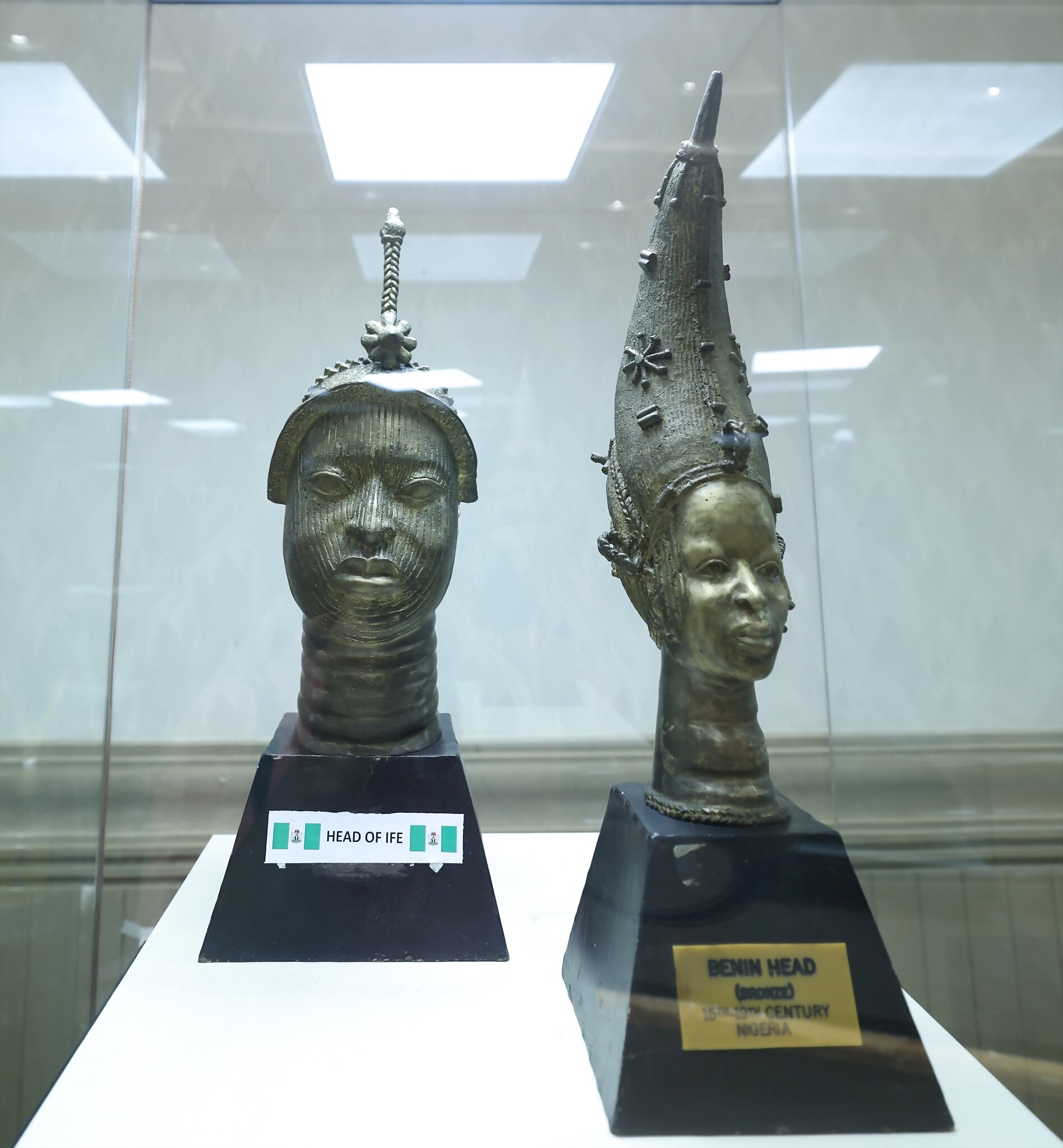
The Ife Bronze Head, part of eighteen sculptures discovered in 1938 at Ife, challenges Western views on African art with its lifelike form, possibly depicting a Yoruba king from the 13th-14th century CE. The Ife Head was taken to the British museum a year after its finding.
OMAN: Soft stone box with narrative decoration
Featured here is a vessel in soft stone that was discovered last year in Wilayat Daba in Musandam Governorate in Oman. Soft stone, with its low index of hardiness, can be moulded easily into vessels. Dating to the time of Iron Age, this container could have formed a node in the larger trade network encompassing Southeast Asia, Southeast Arabia and the Gulf.
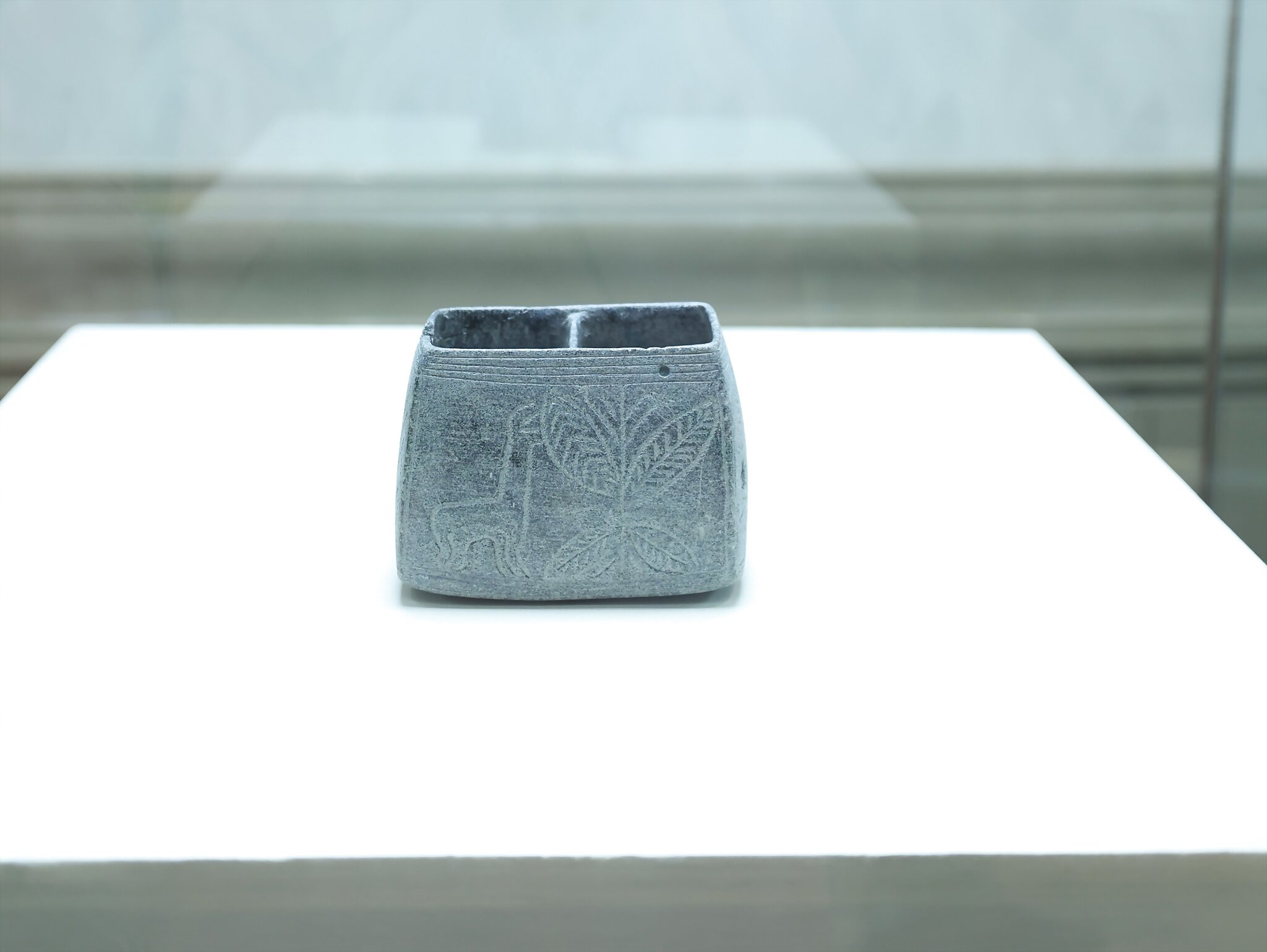
The container reflects the craftsmanship of Omani potters and artists who creatively integrated various motifs, patterns and designs inspired by daily life, folktales and mythology.
SINGAPORE: Different packagings of NEWater and NEWbrew
This display maps NEWater’s impressive odyssey, propelling Singapore’s endeavours towards water sustainability. A 1974 pilot plant pioneered the transformation of wastewater into potable water. However, expenses and unproven reliability led authorities to explore the option of reclaiming drinking water using membrane technology.

In 2002, this high-grade water was named NEWater, and thereafter it became woven into Singapore’s social fabric. It earned the 2008 Global Water Award for ‘Environmental Contribution of the Year.’ In 2018, NEWBrew, a craft beer brewed from NEWater was introduced. These innovations spotlight NEWater’s role in Singapore’s water sustainability, serving as a global model. Furthermore, this Water Reclamation Plant and the National Environment Agency’s Integrated Waste management facility will harness potential energy recovery from the water-energy-waste nexus.
SPAIN: Abanicos (Hand Fans)
Spain’s G20 Digital Museum Culture Corridor contribution is the ‘Diseñar el aire’ (Designing Air) exhibit. It presents the iconic Spanish fan heritage, spotlighting exclusive designs by 16 acclaimed creators. This display reimagines traditional fans with innovative shapes and textures. Pioneering the fusion of design, craftsmanship, and fashion, it revitalises this ancient accessory through modern materials and technology.
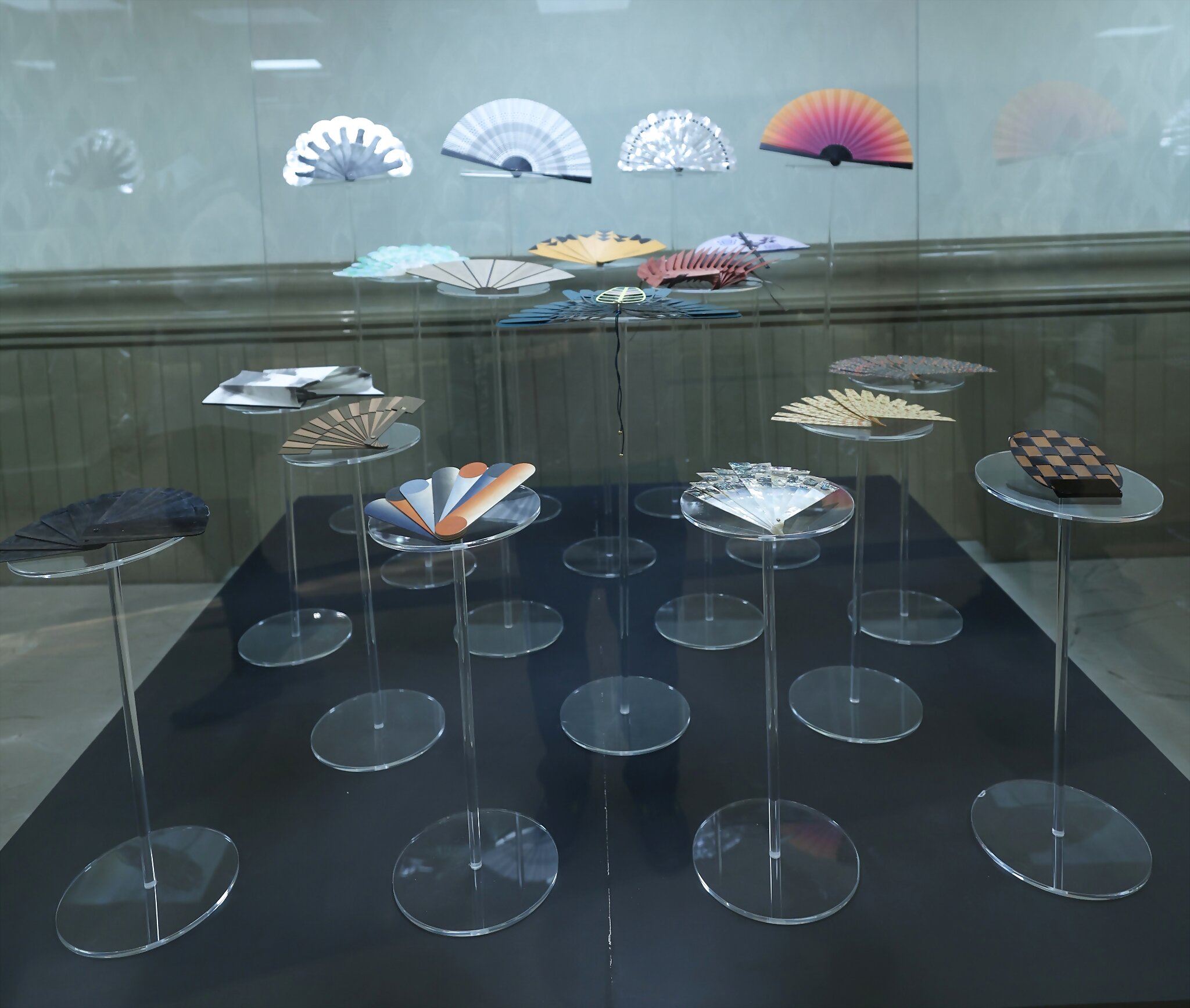
Spanish fans, functional and artistic since the 16th century, had regional production centers including Madrid, Valencia, Barcelona, Malaga, and Seville. The fan symbolised Spanish femininity and the bourgeois culture in the Romantic era. In the 20th century, the fan transcended spaces and social classes. Since World War I, Valencia has led the global fan production. The Aldaia Fan Museum (MUPA) has collaborated in this initiative to revitalise Spanish fan design by uniting history with innovation.
UAE: Replica of a Horse Gold Bridle
This is a horse bridle from Mleiha in Sharjha Emirates, dating to the 1st-2nd century CE. It offers the earliest evidence of horses in Southeast Arabia, in the form of skeletal remains and a pictorial representation. Gold trappings were buried alongside camels, underlining the prosperity of this region.
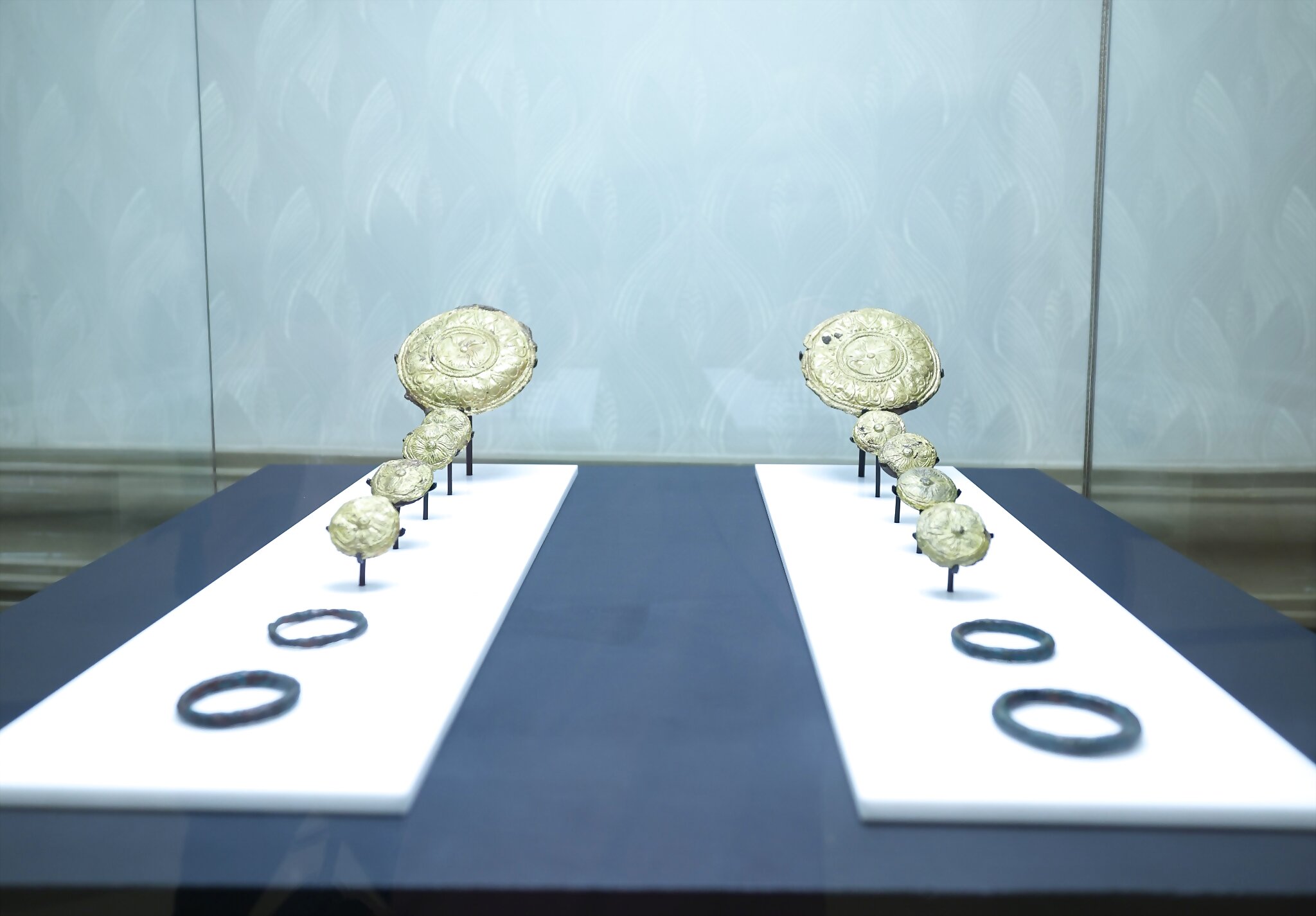
Decorative circular discs, affixed with bronze rings, hint at foreign origins. These trappings, echoing affluence, illuminate robust economic exchanges and cultural ties among civilisations. The Golden Bridle and Trappings mirror UAE’s contribution as a melting pot of various cultures since ancient times.



















Comments
0 comment